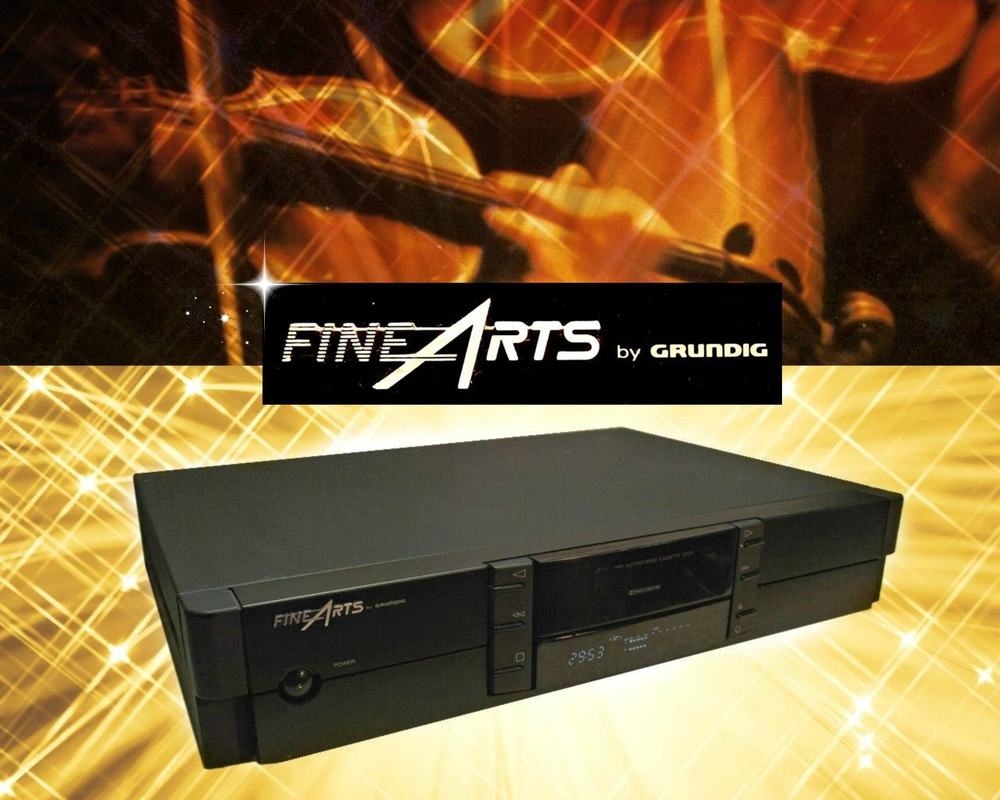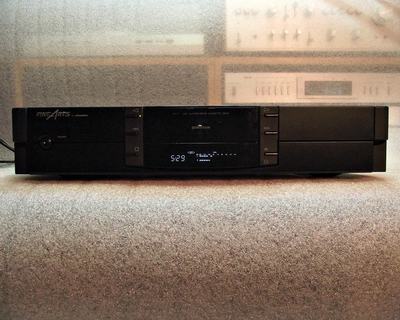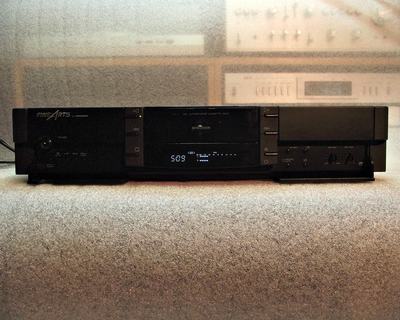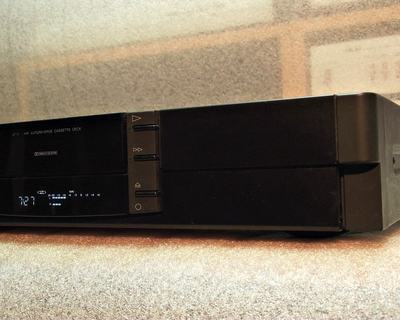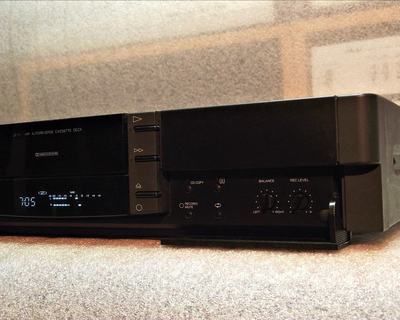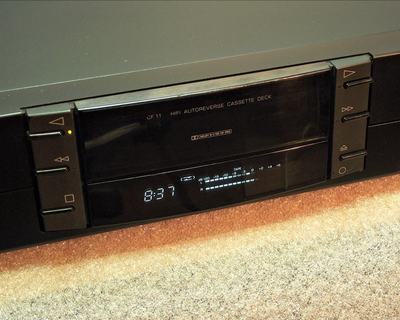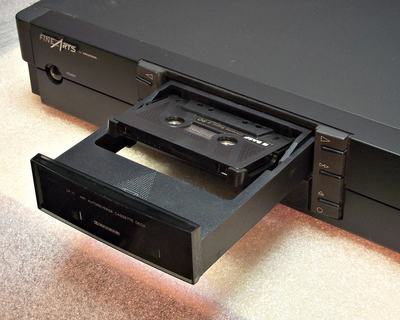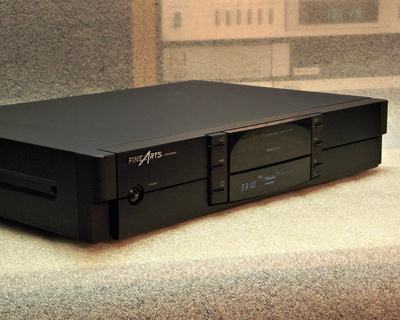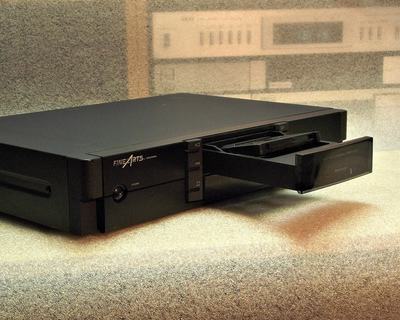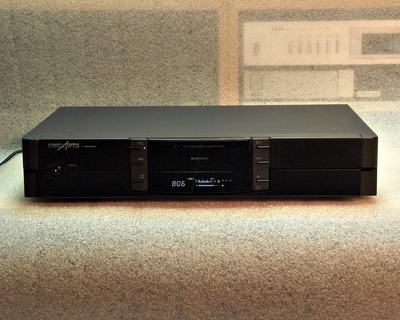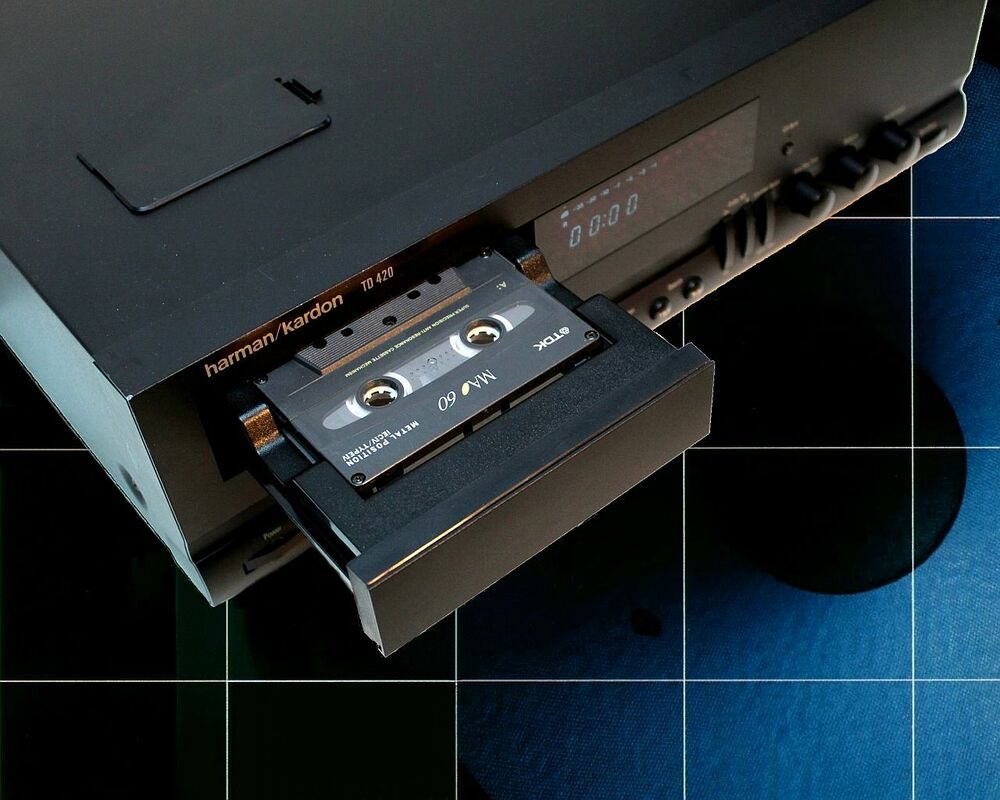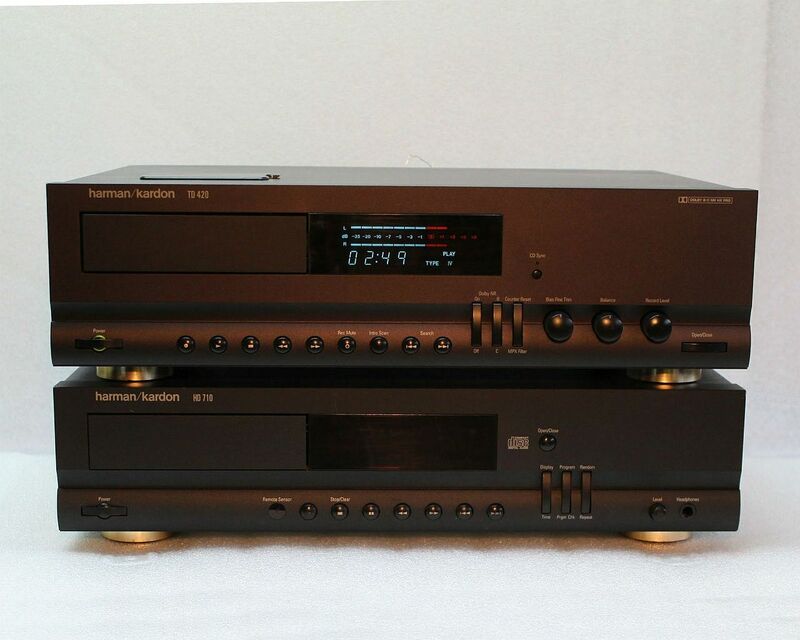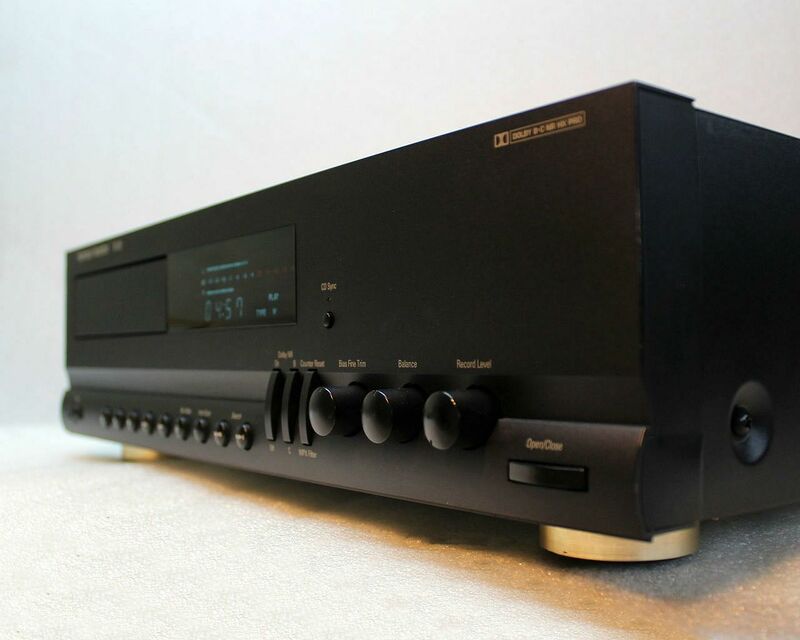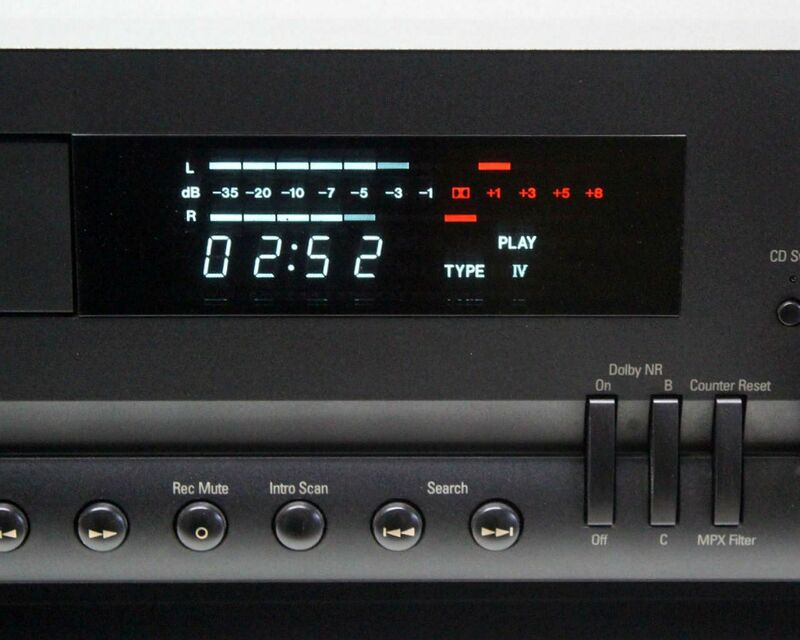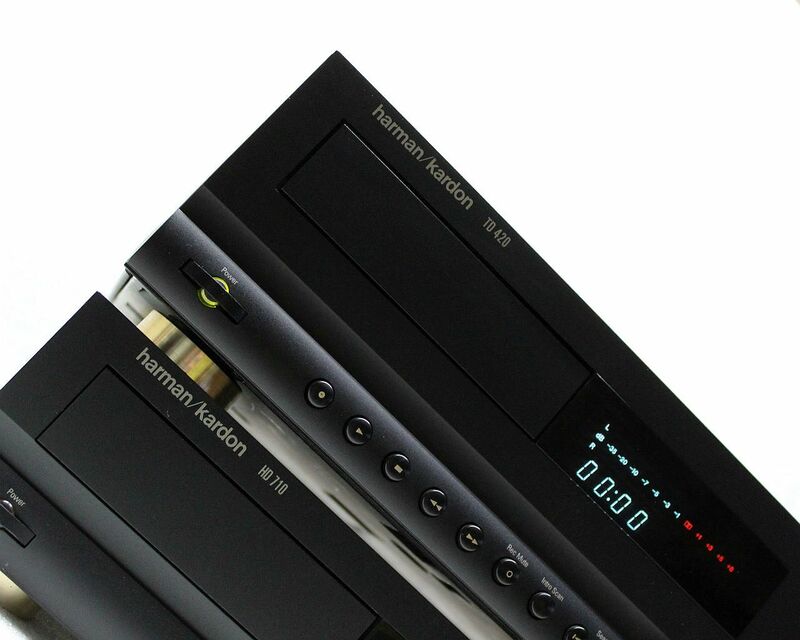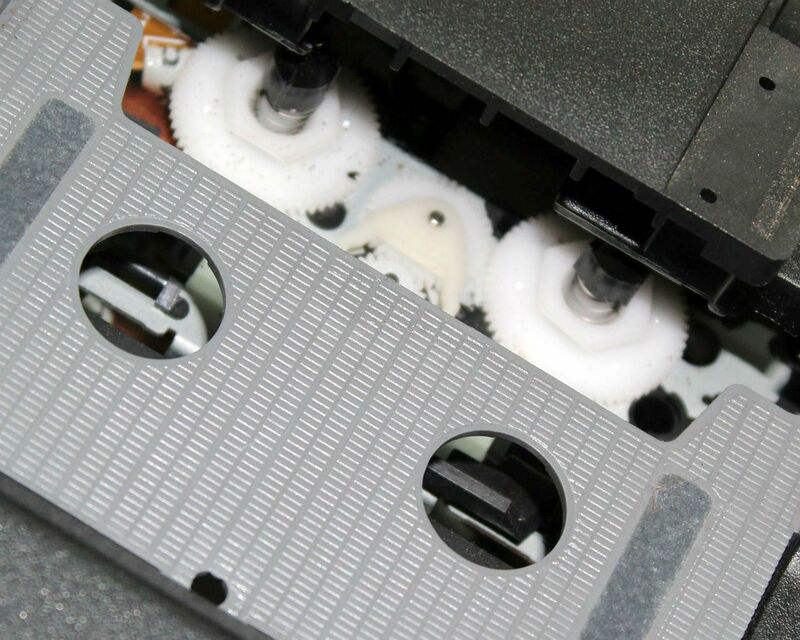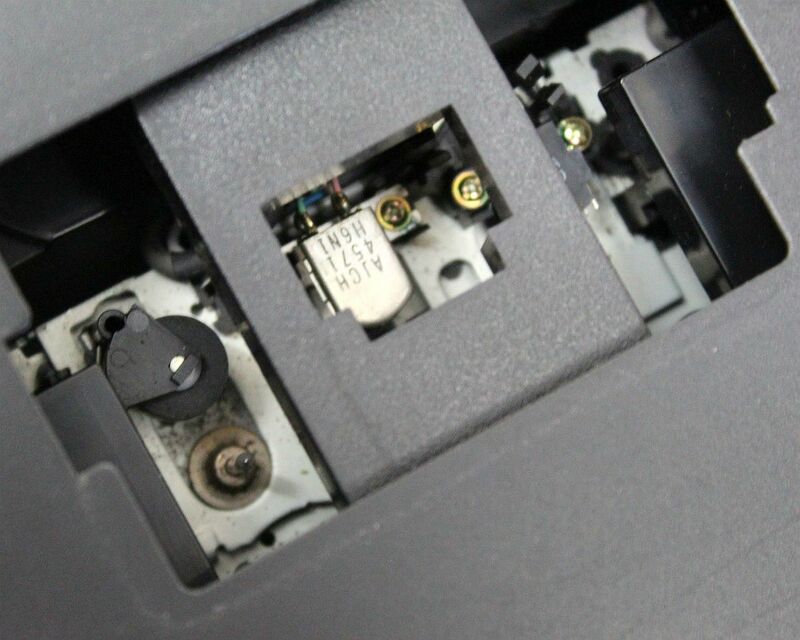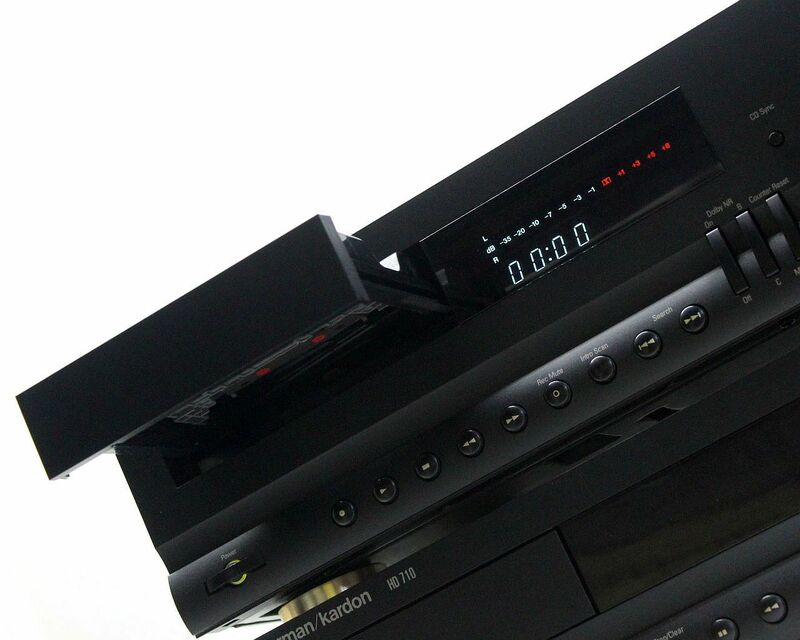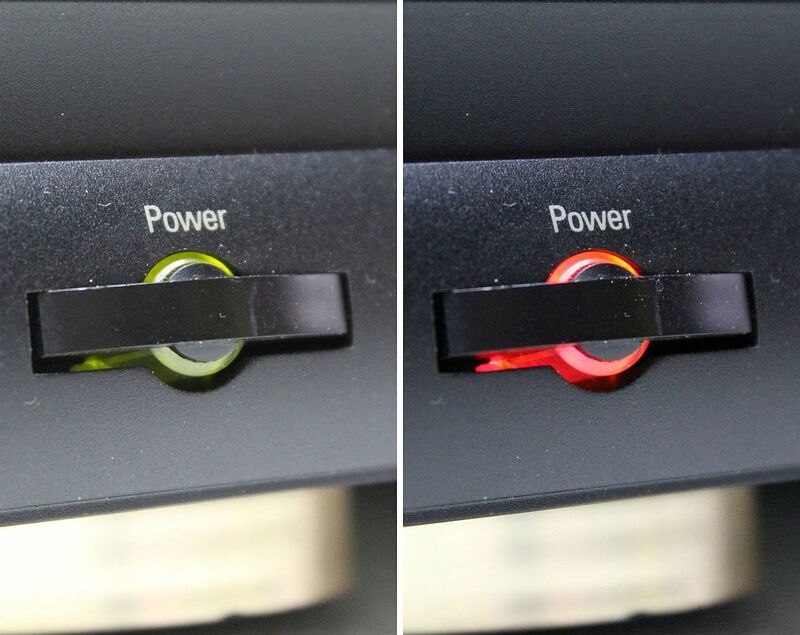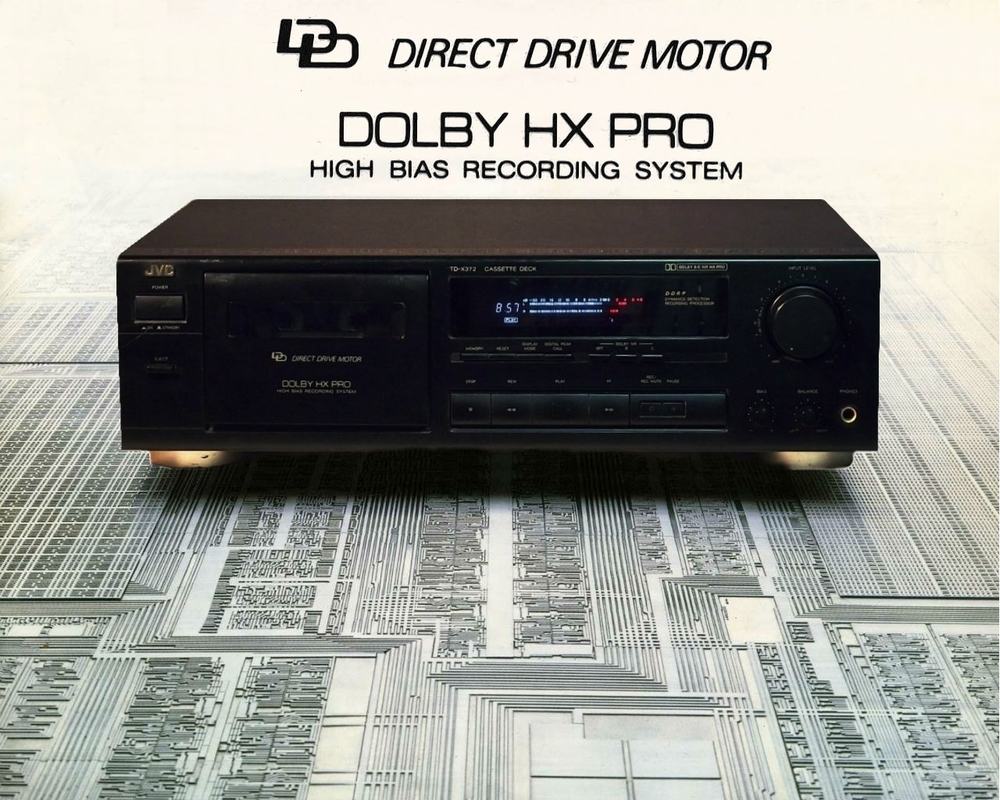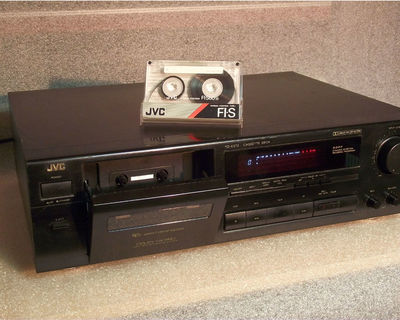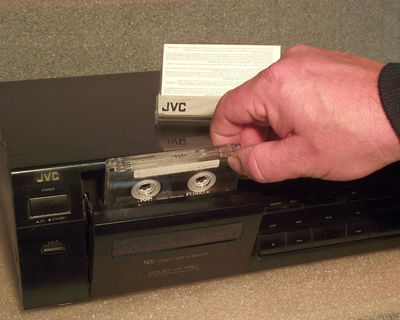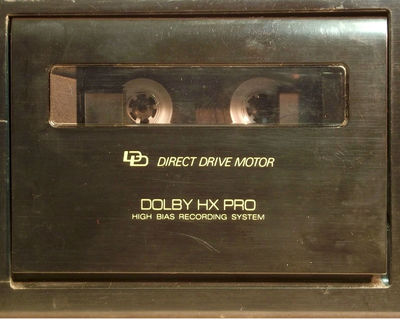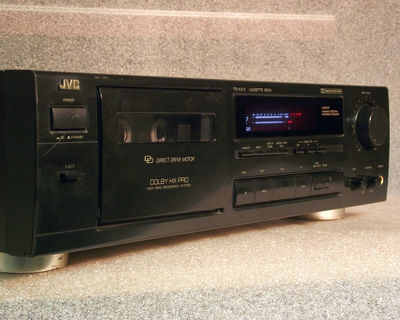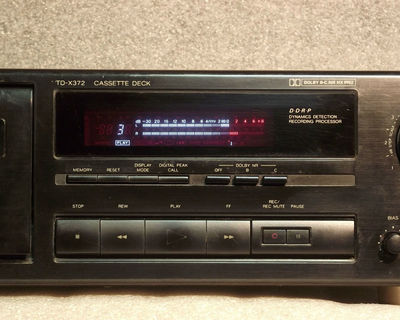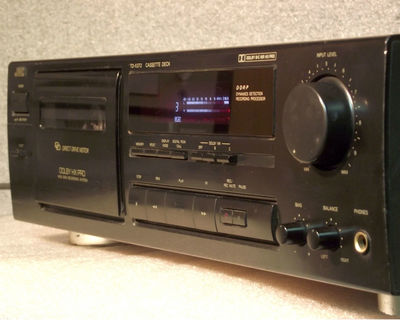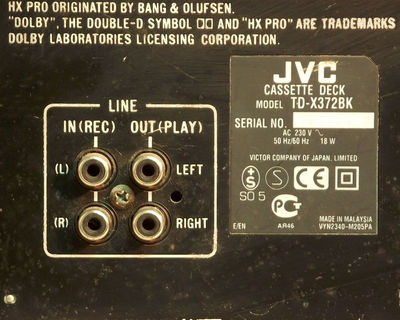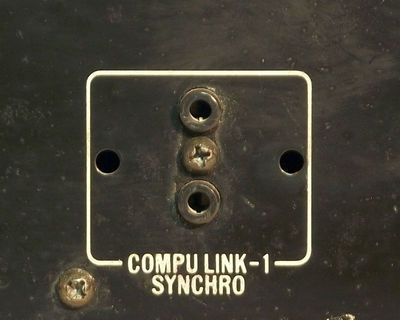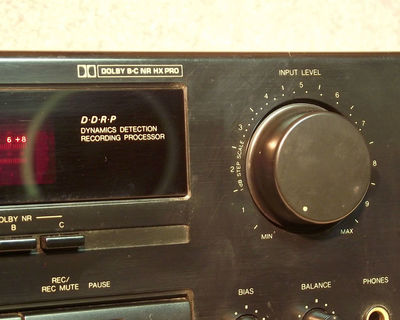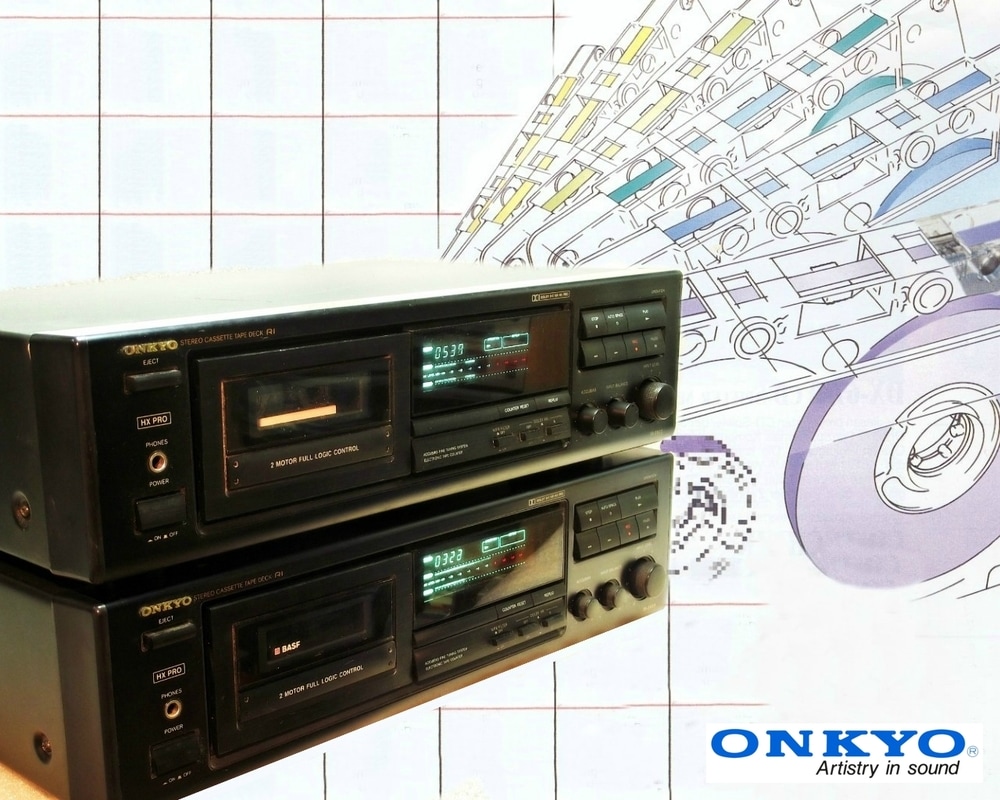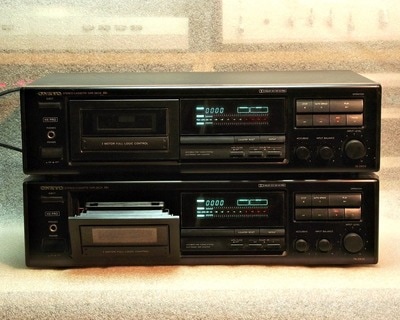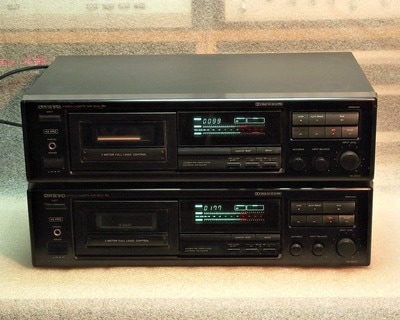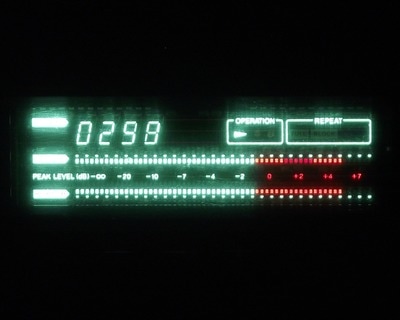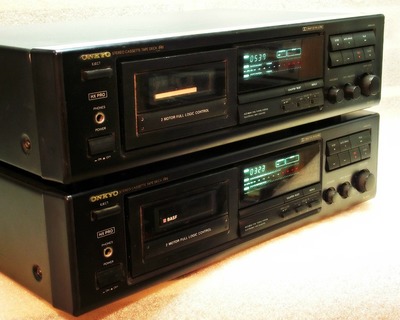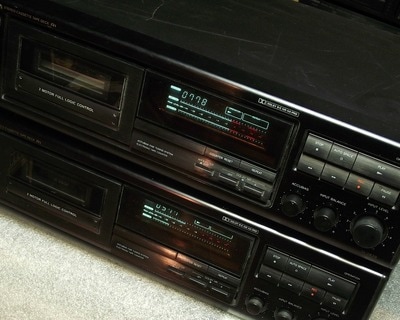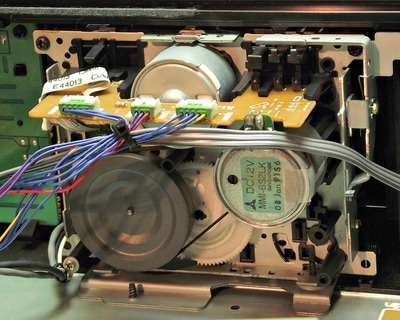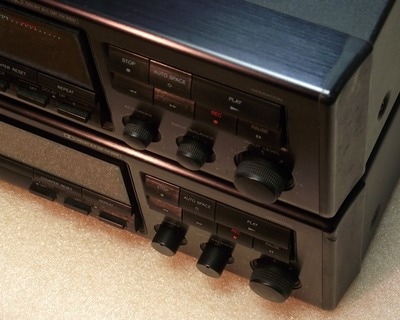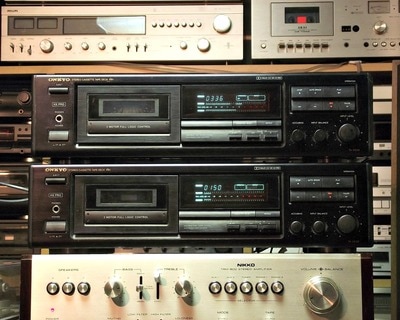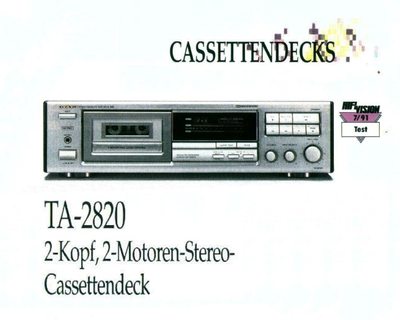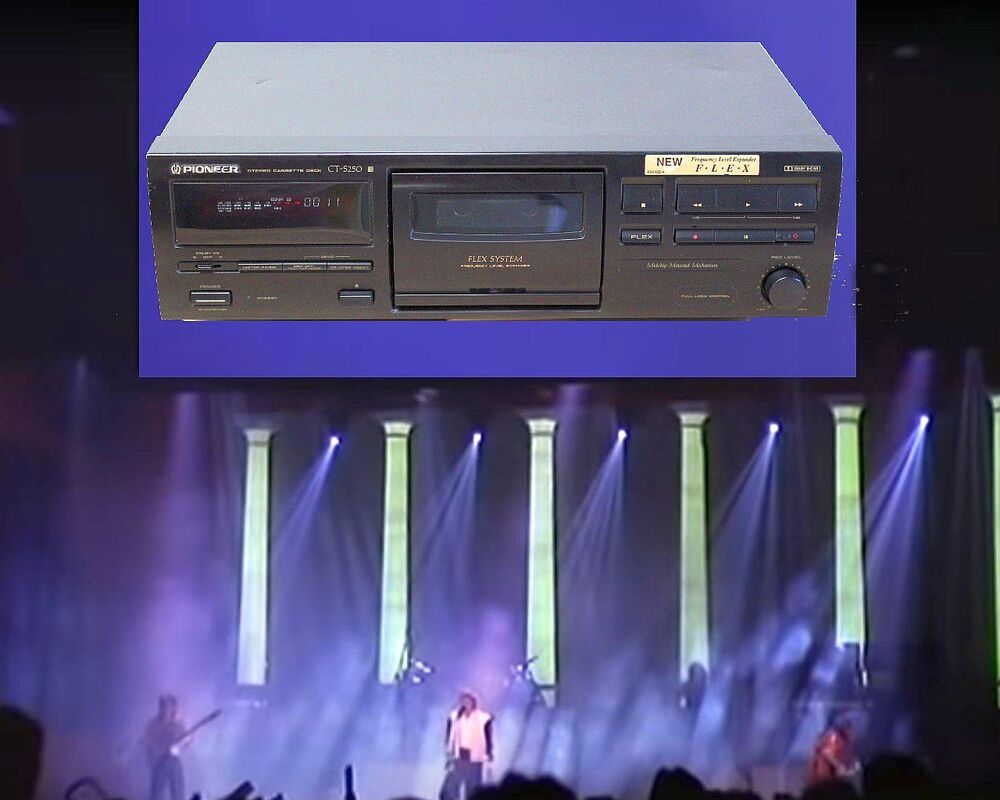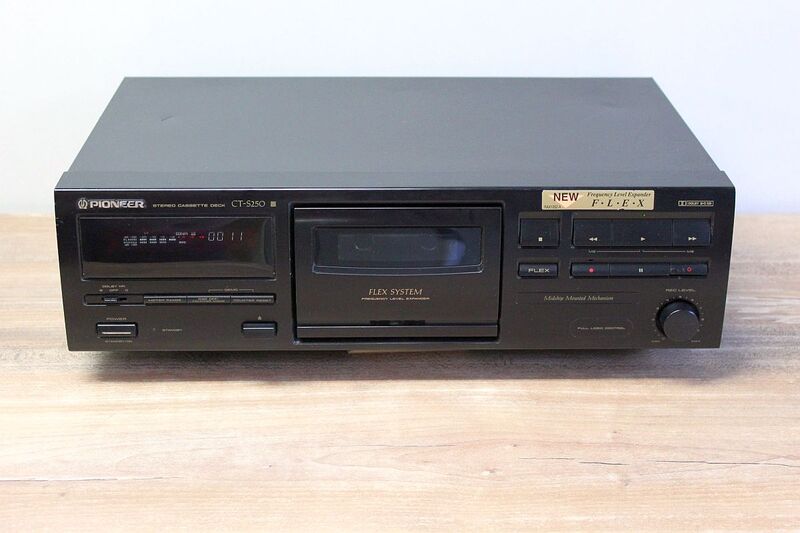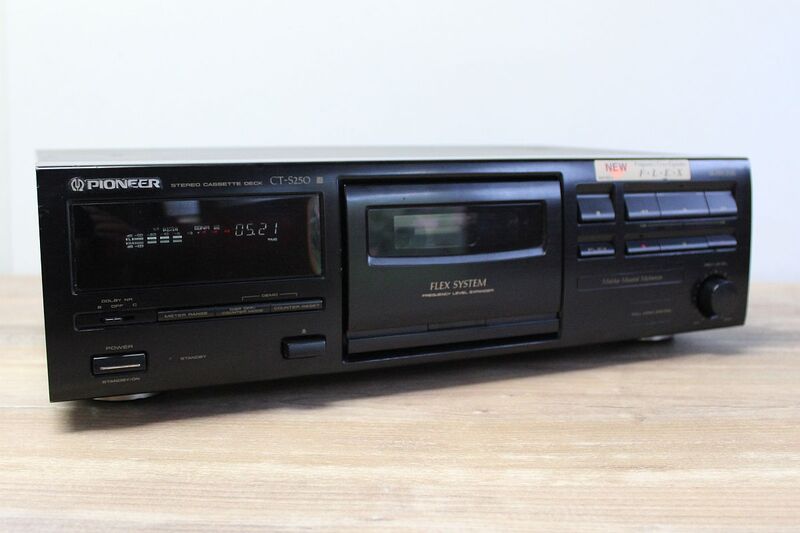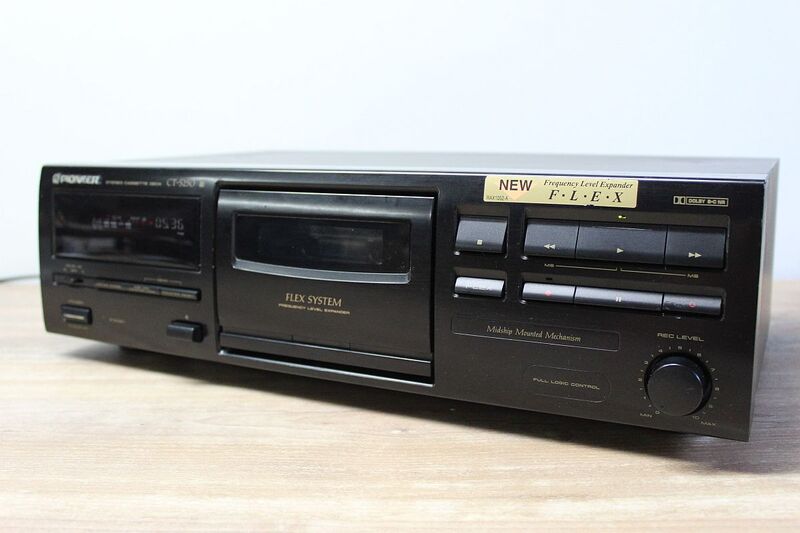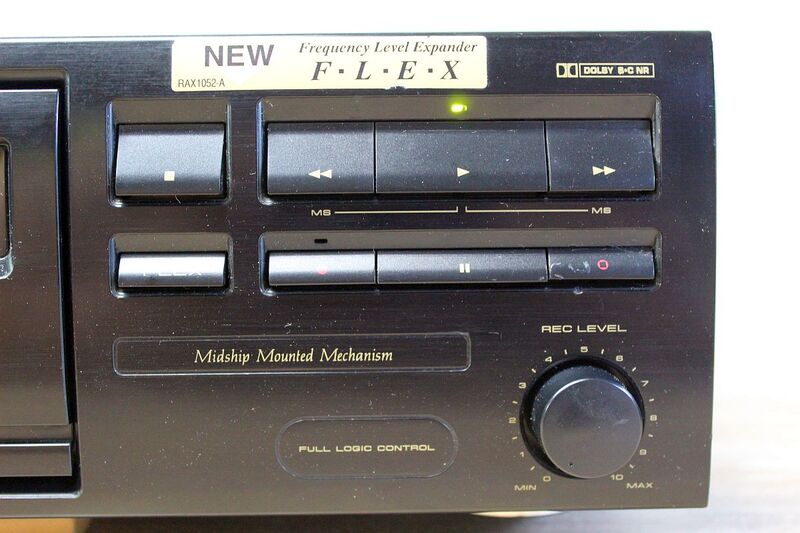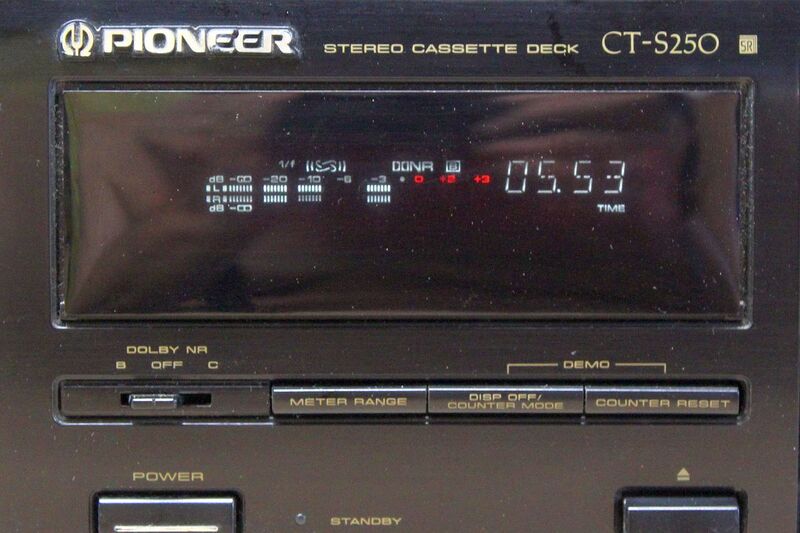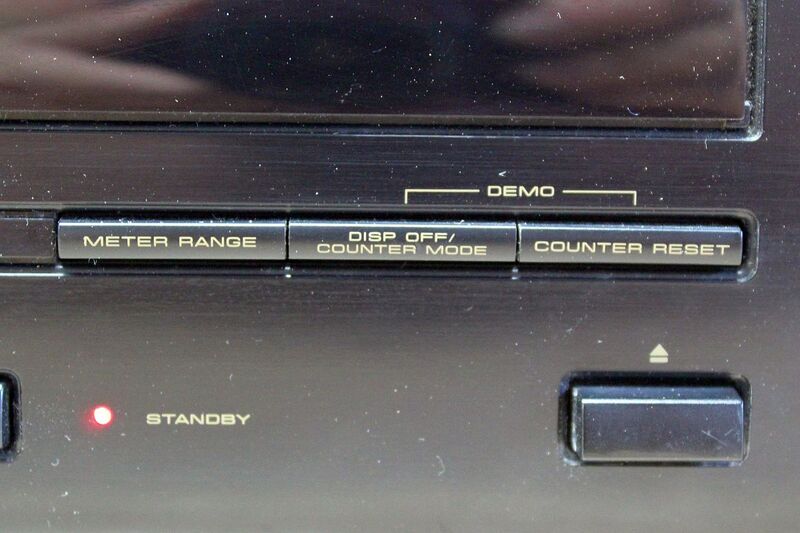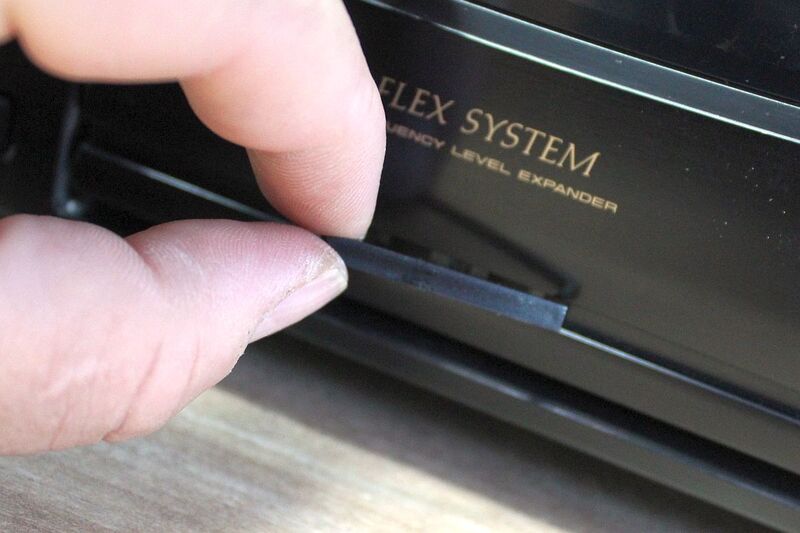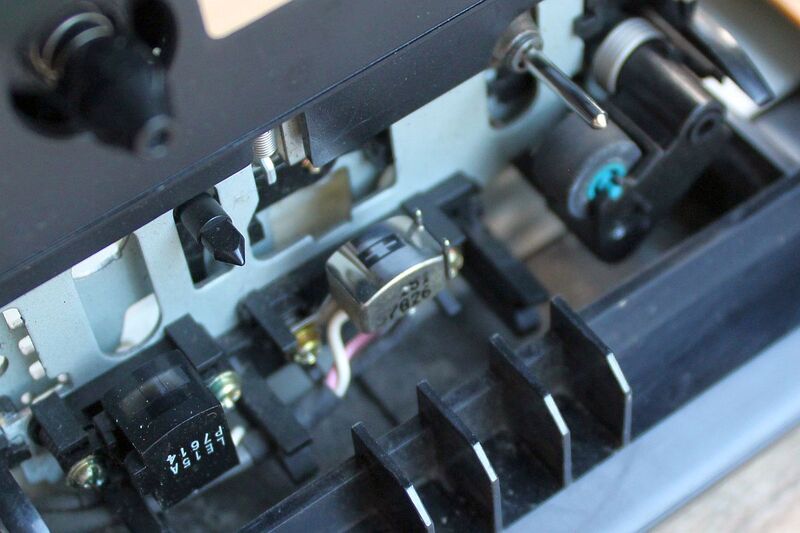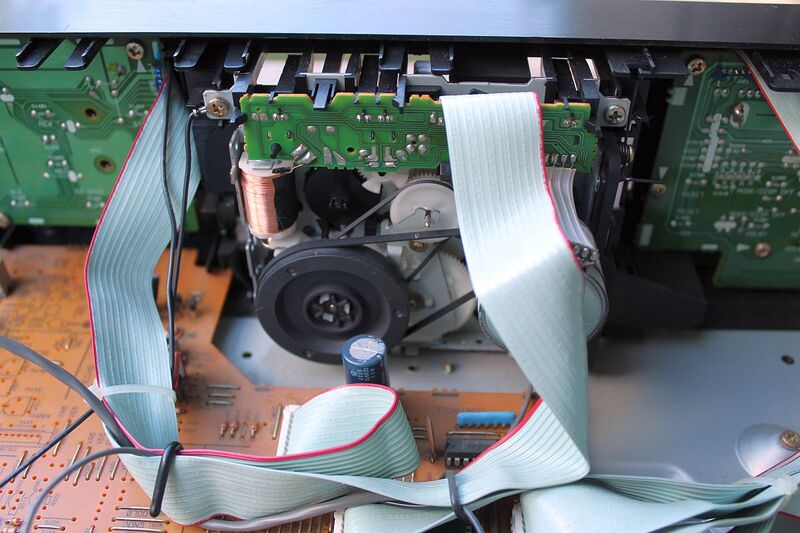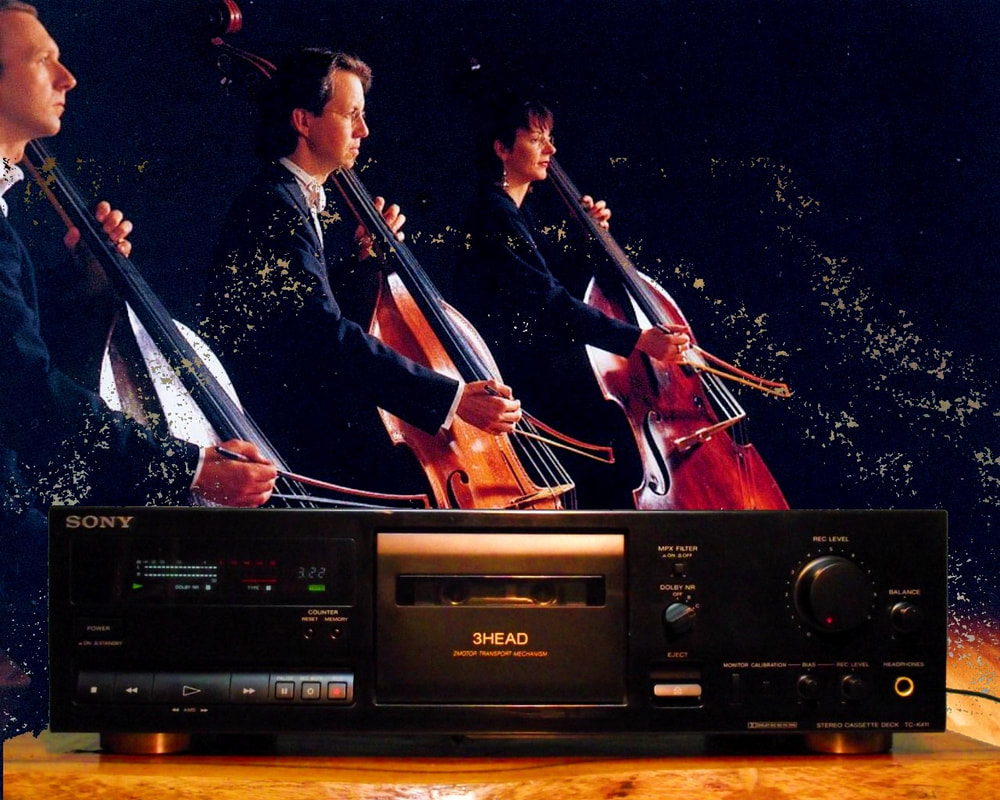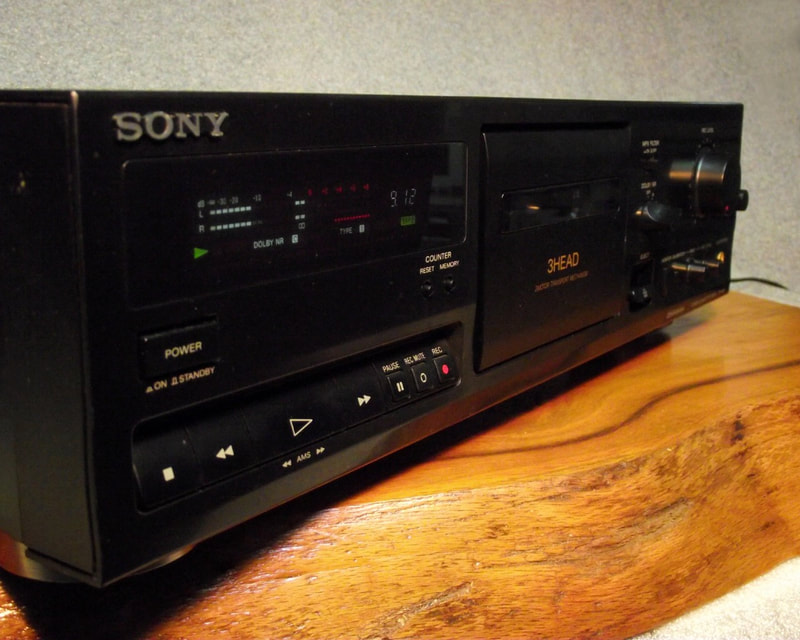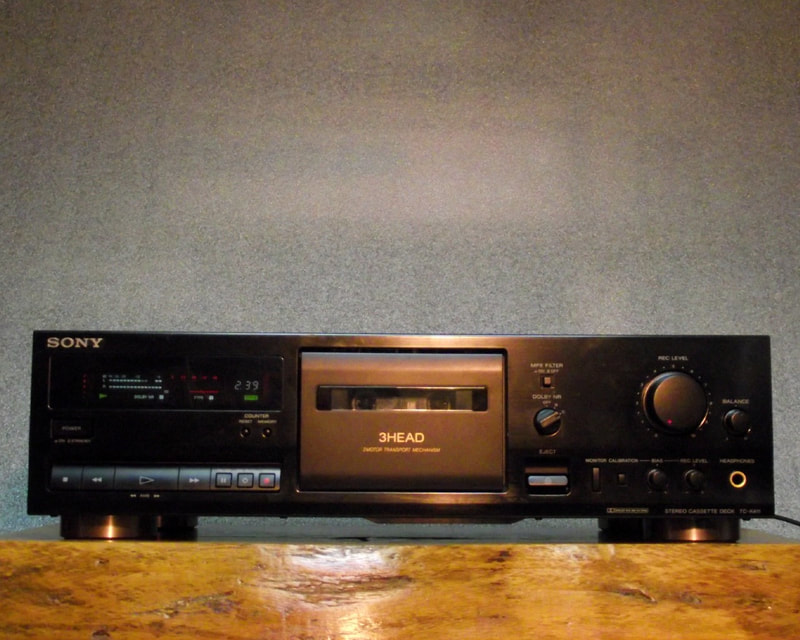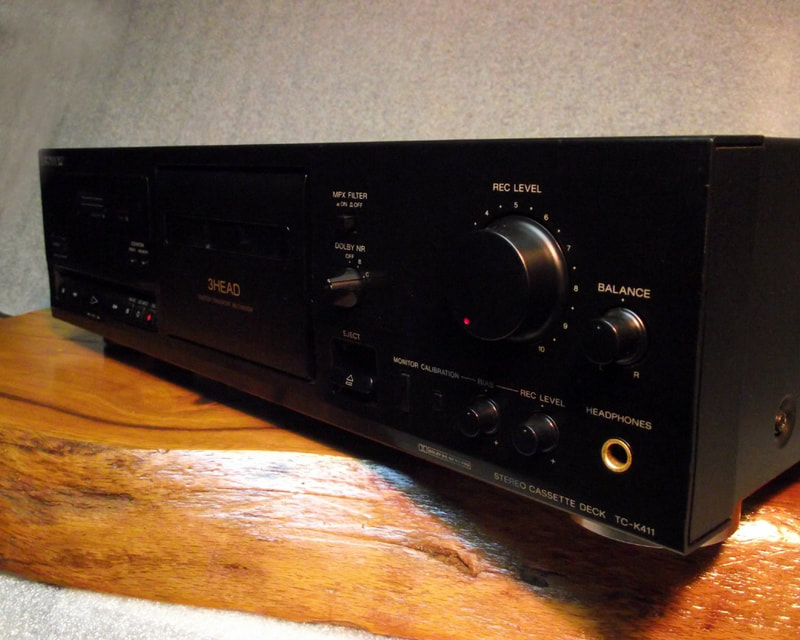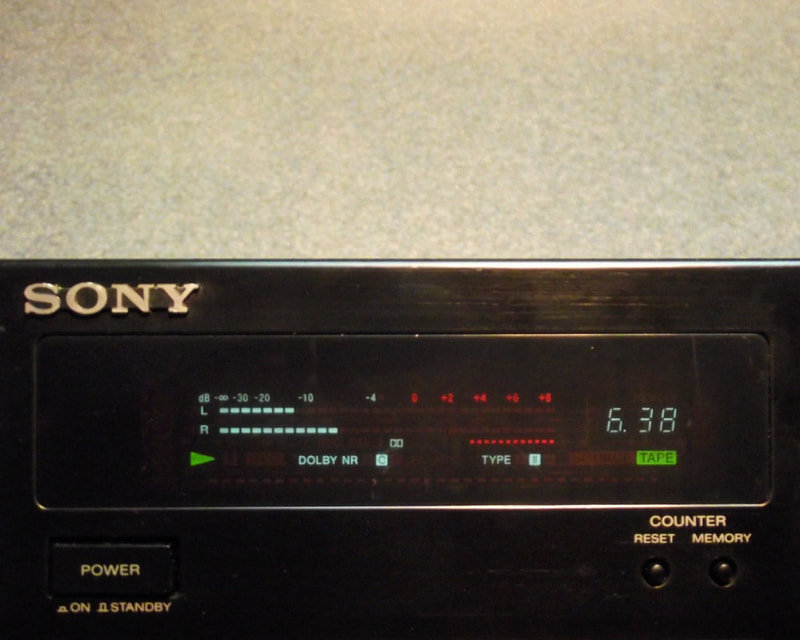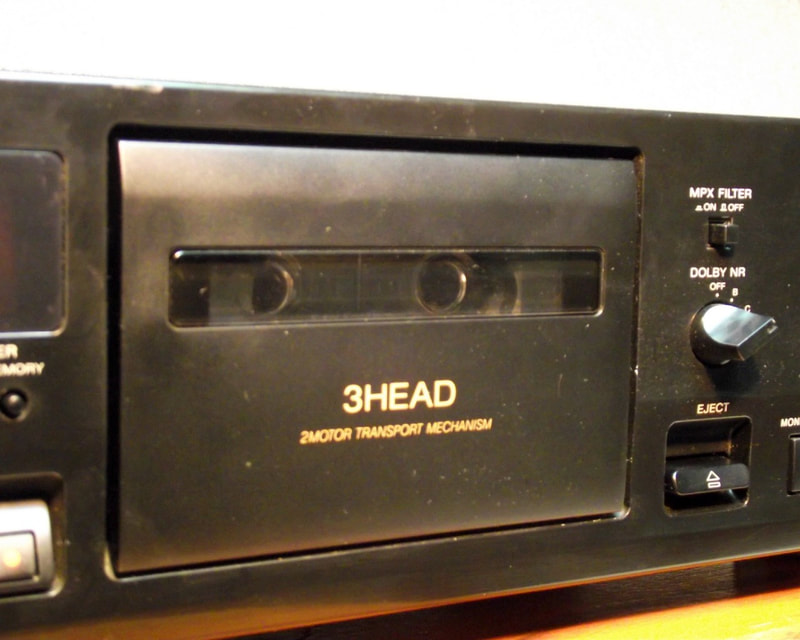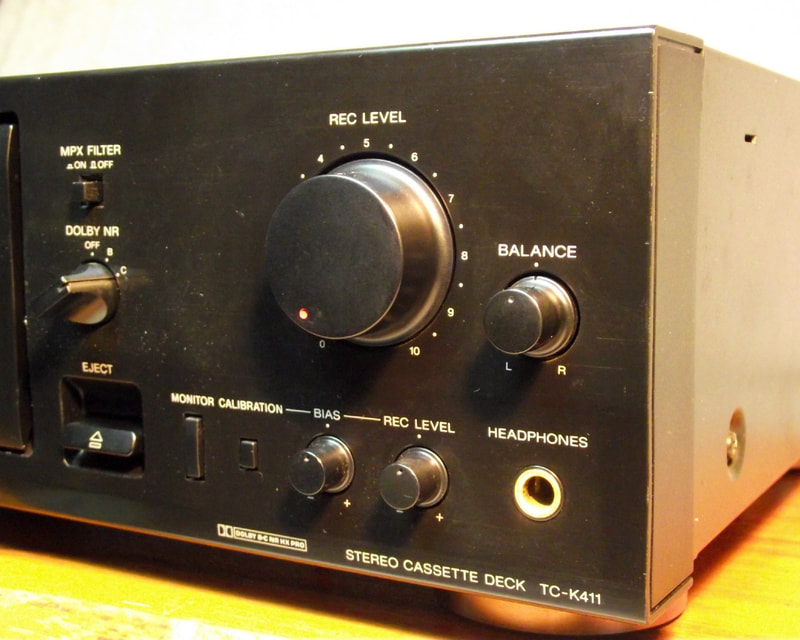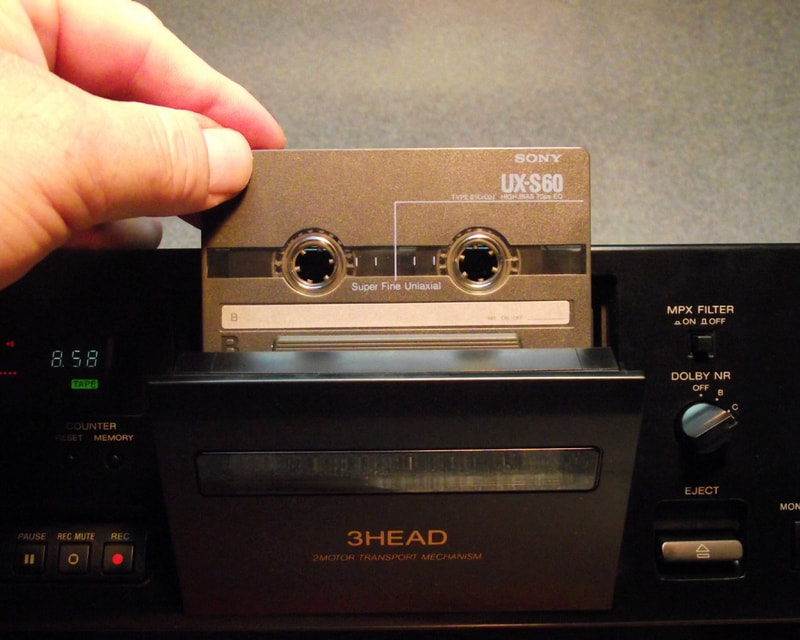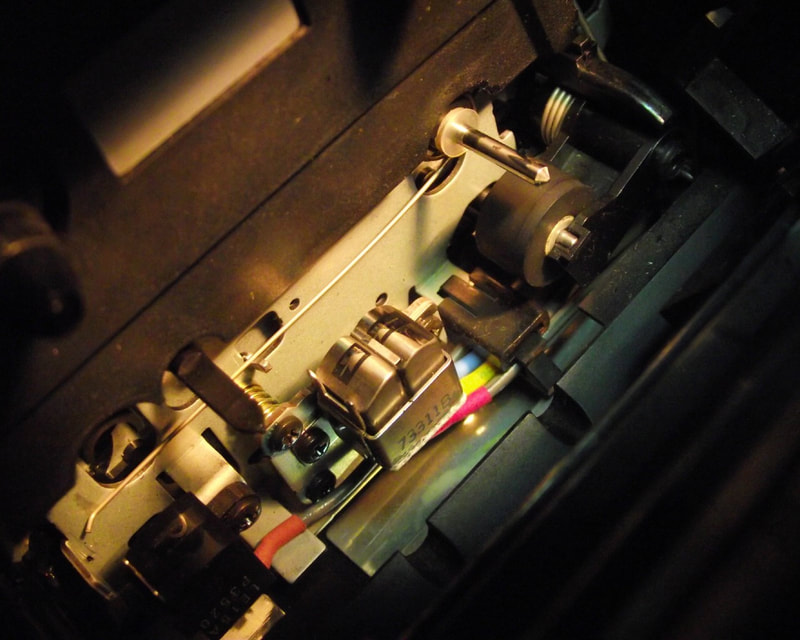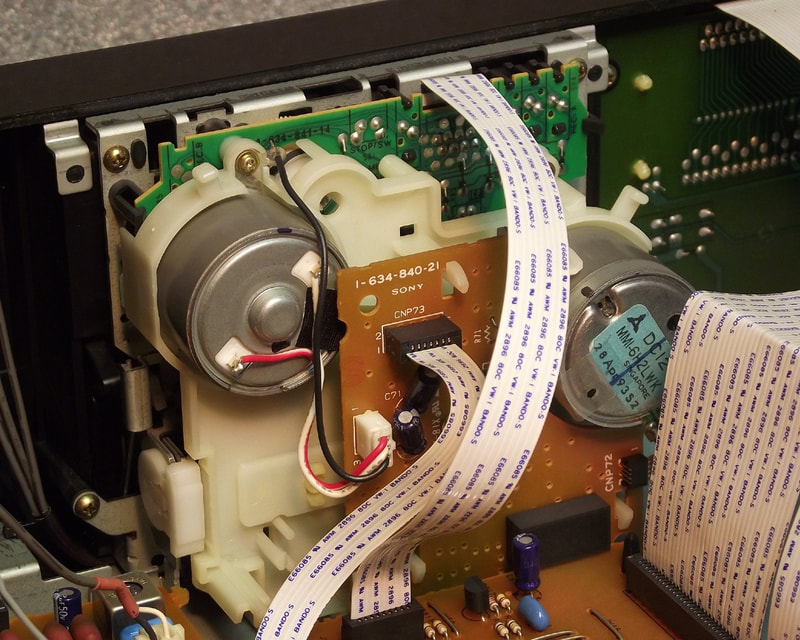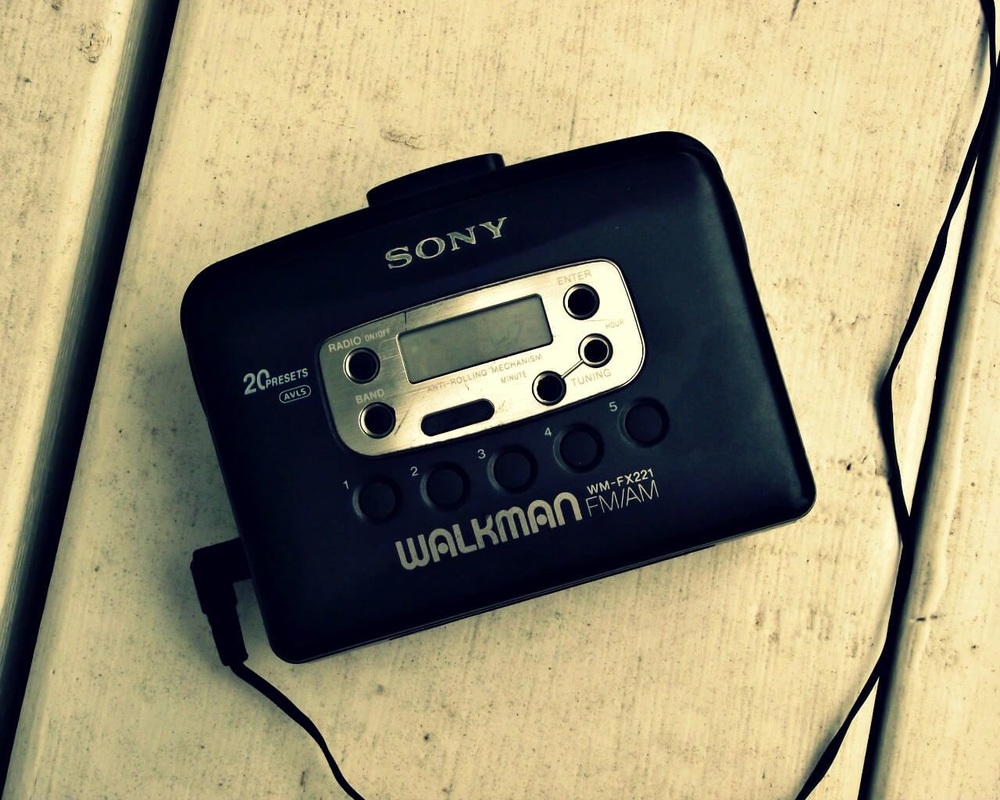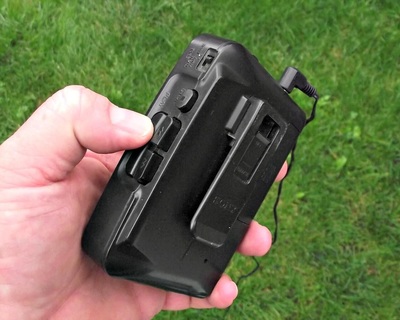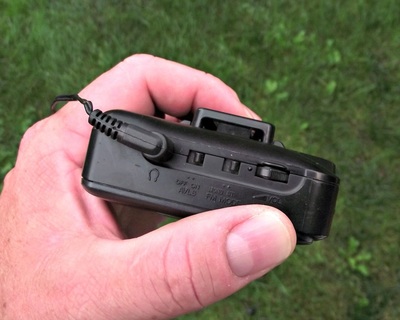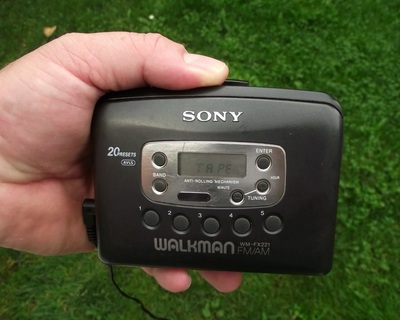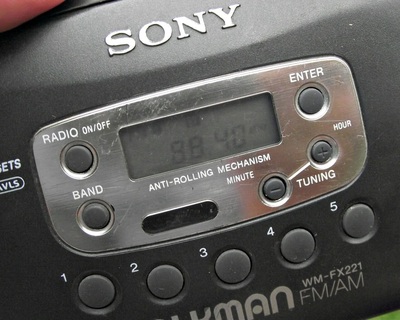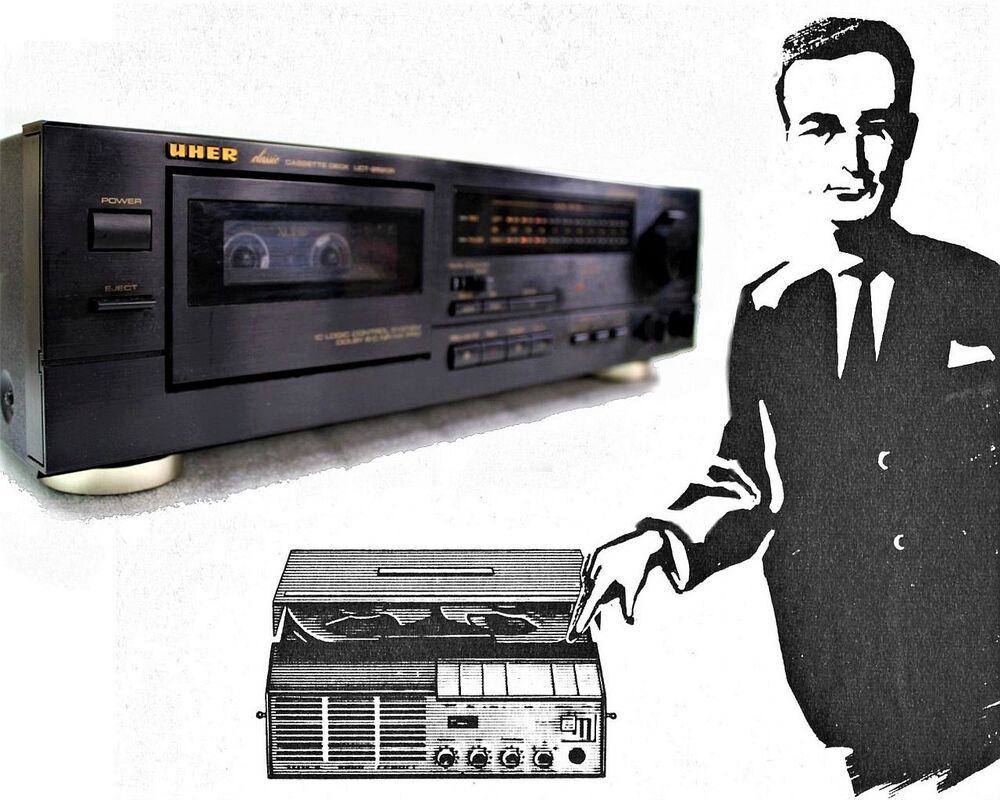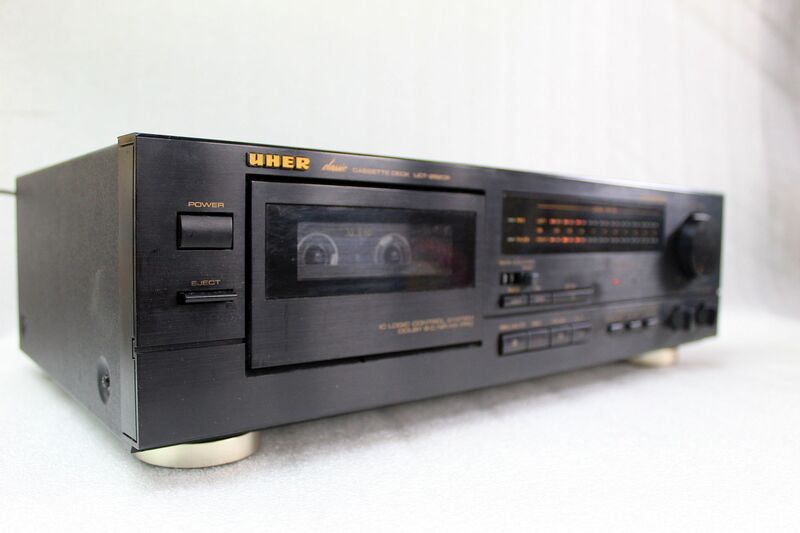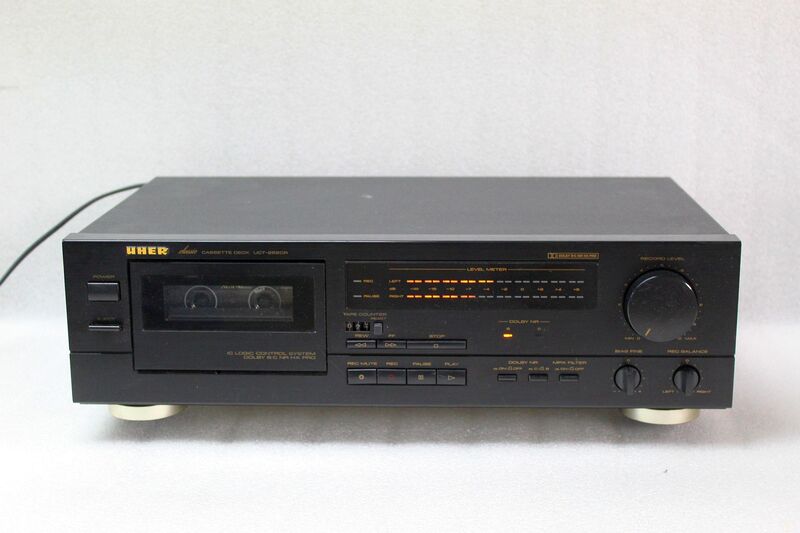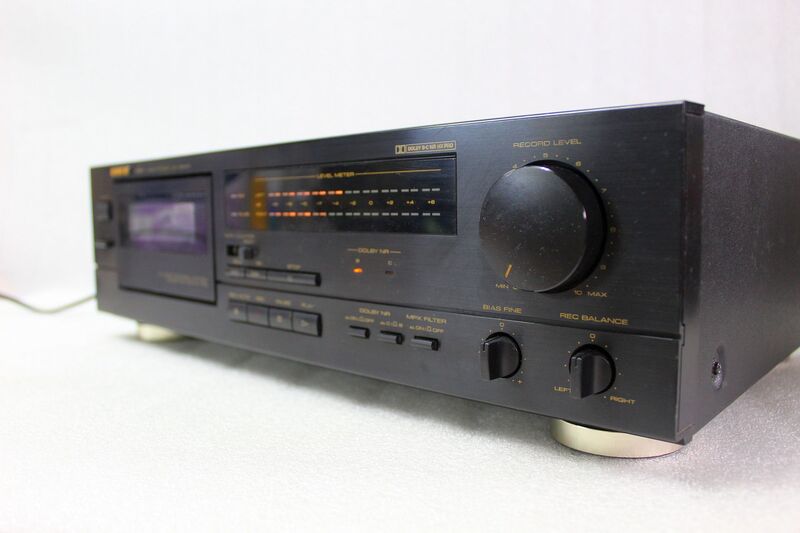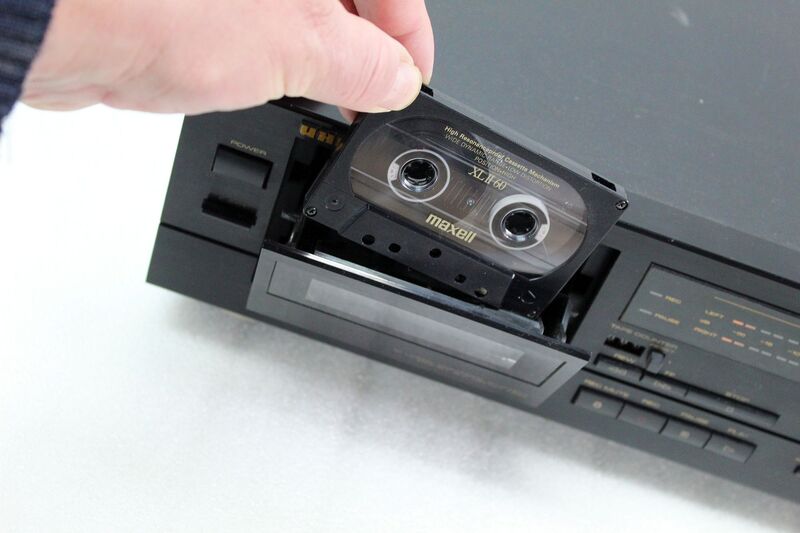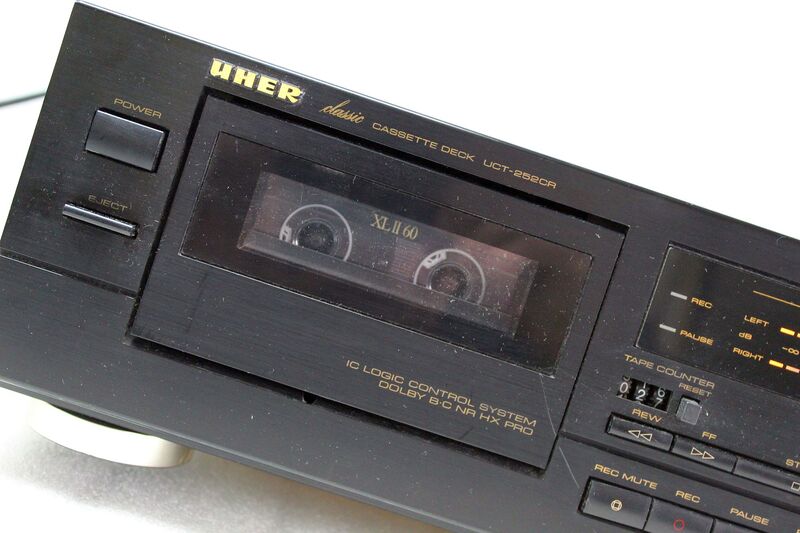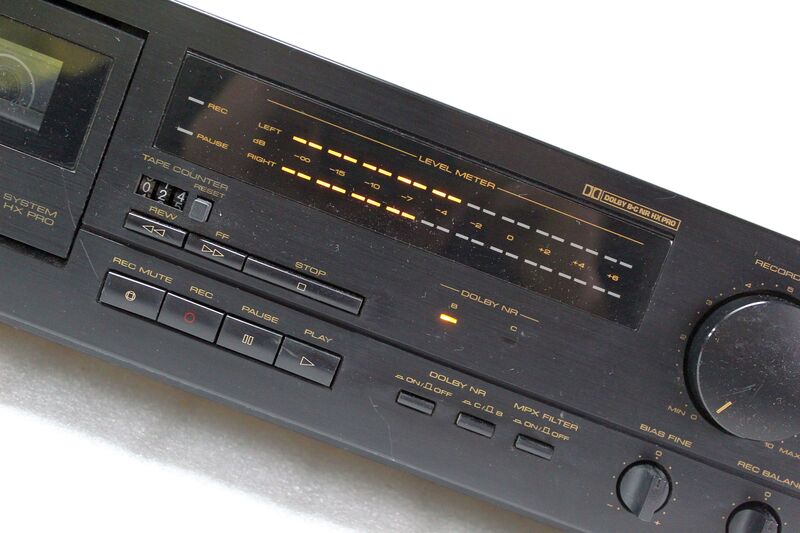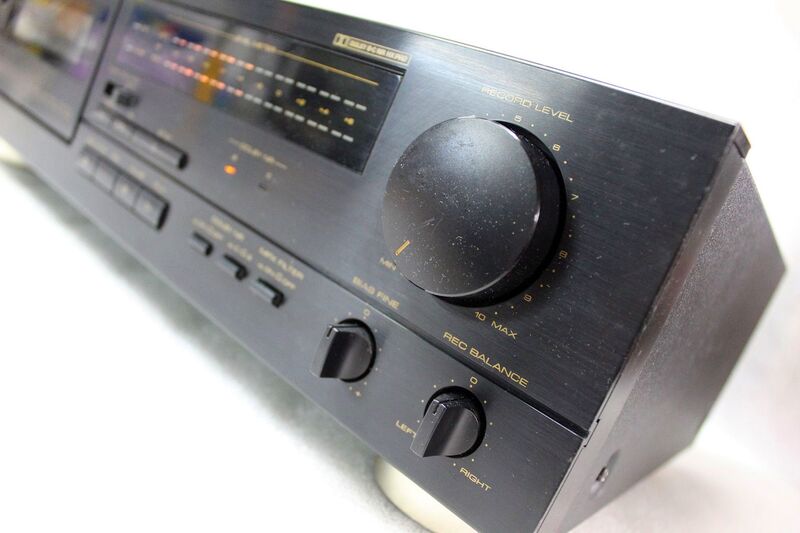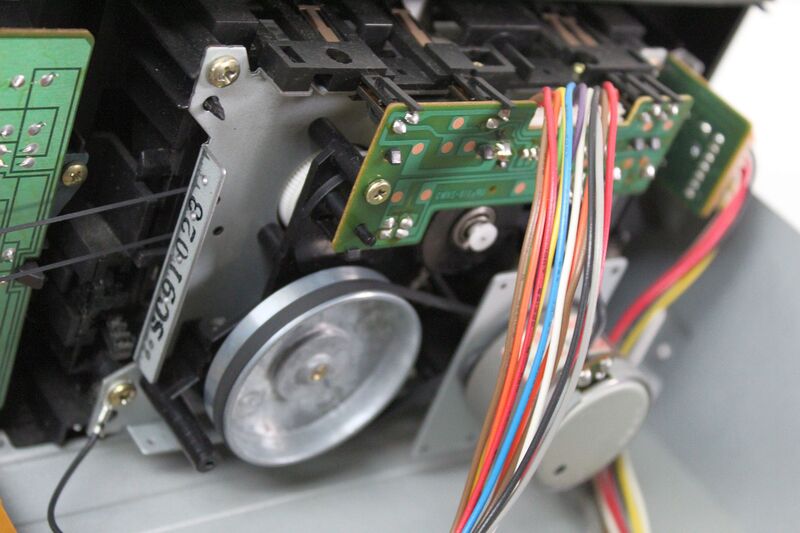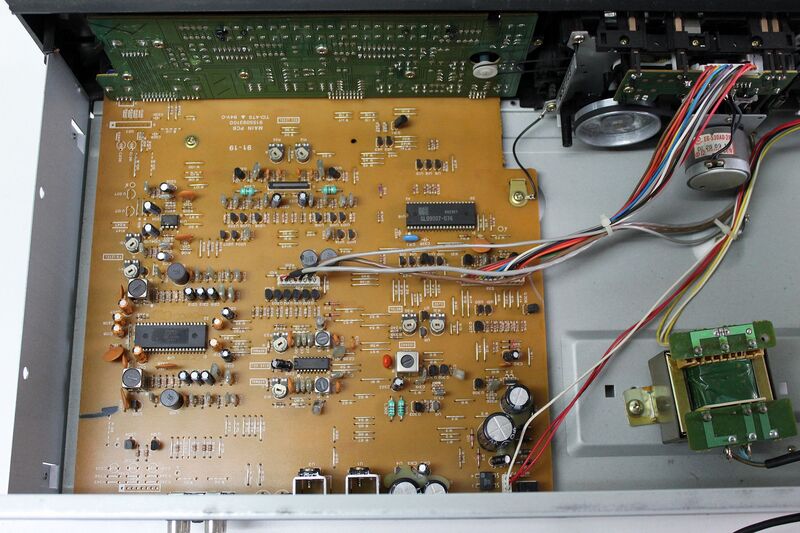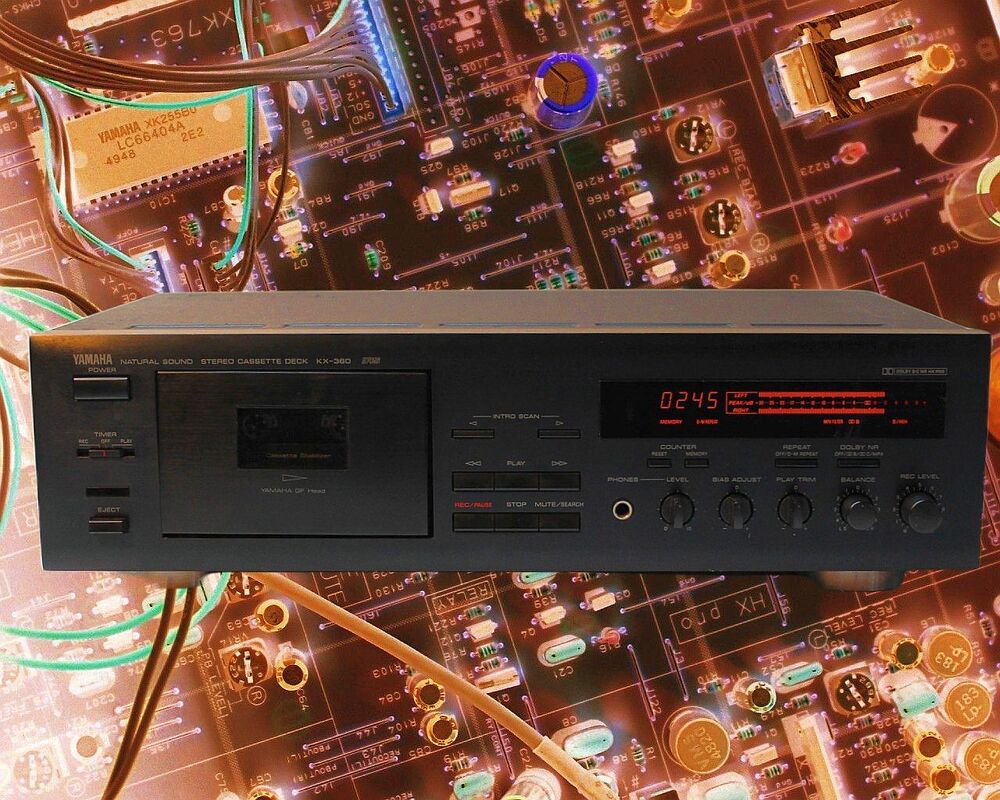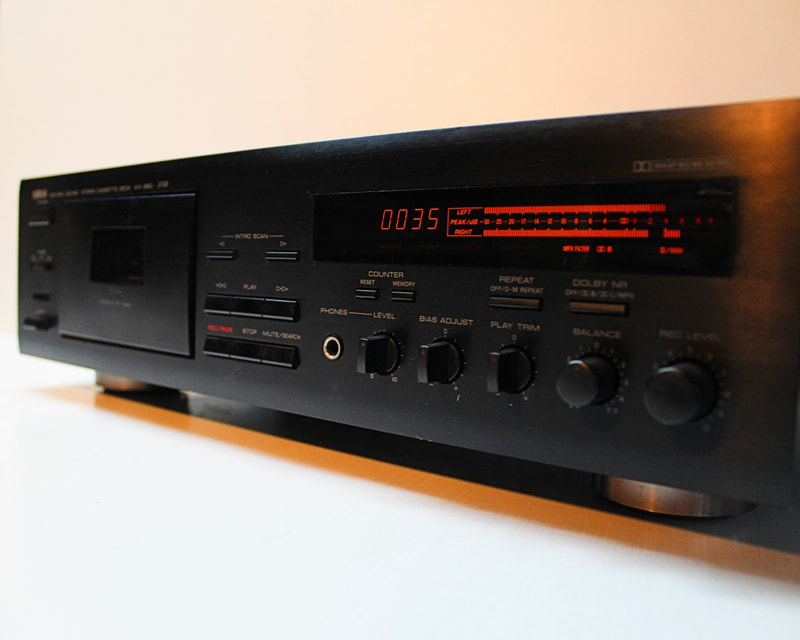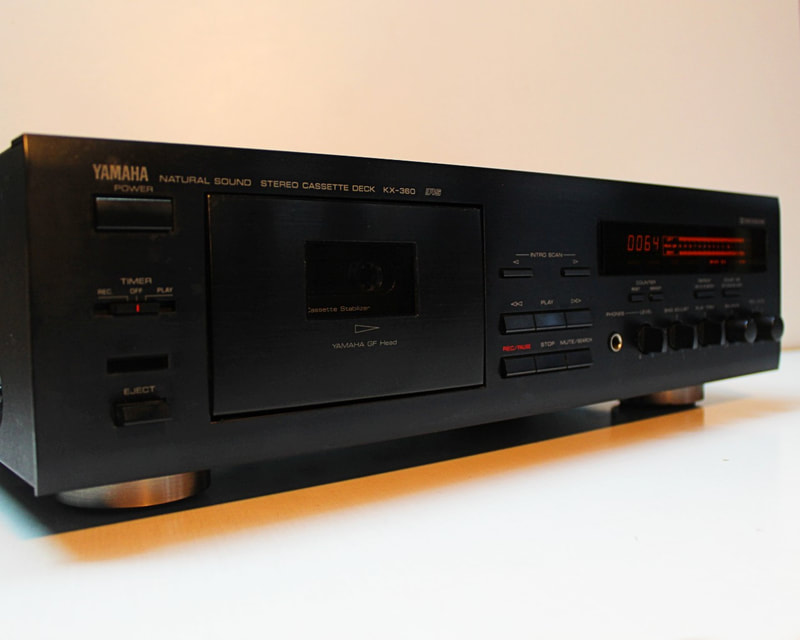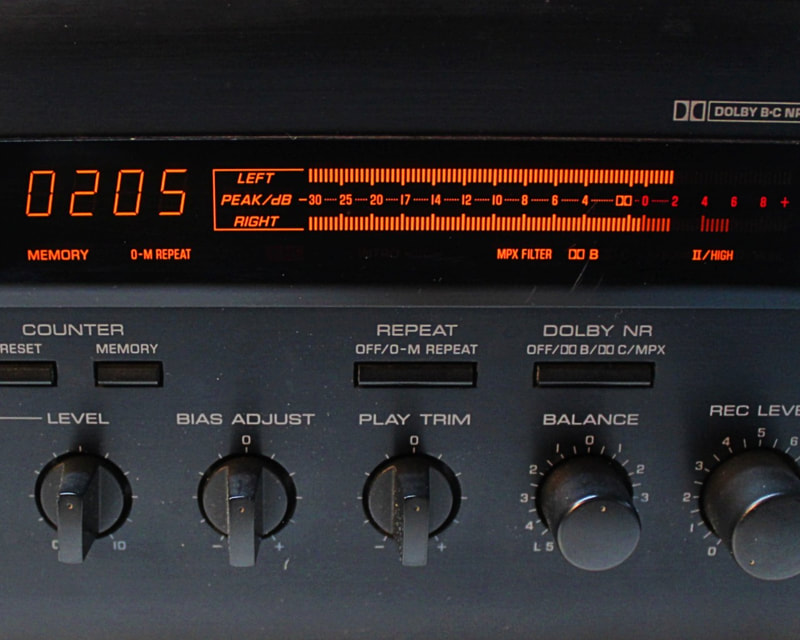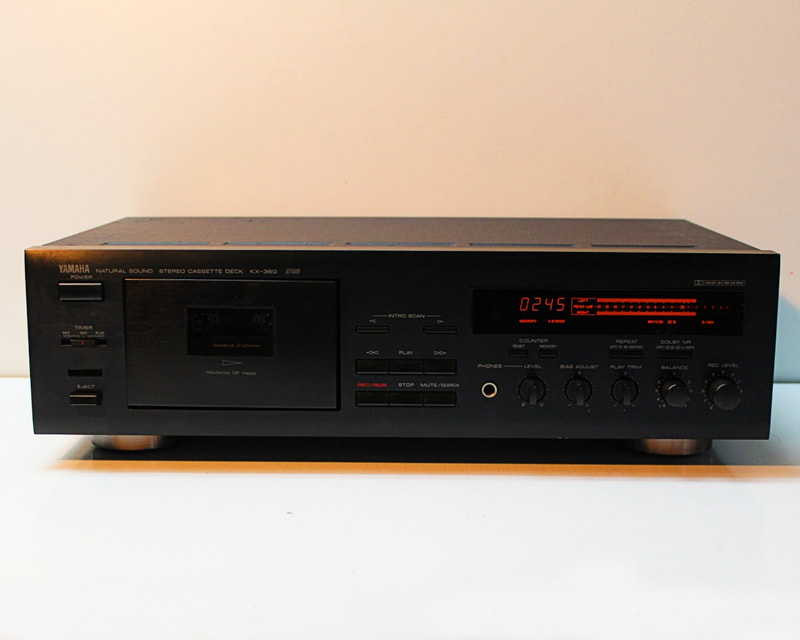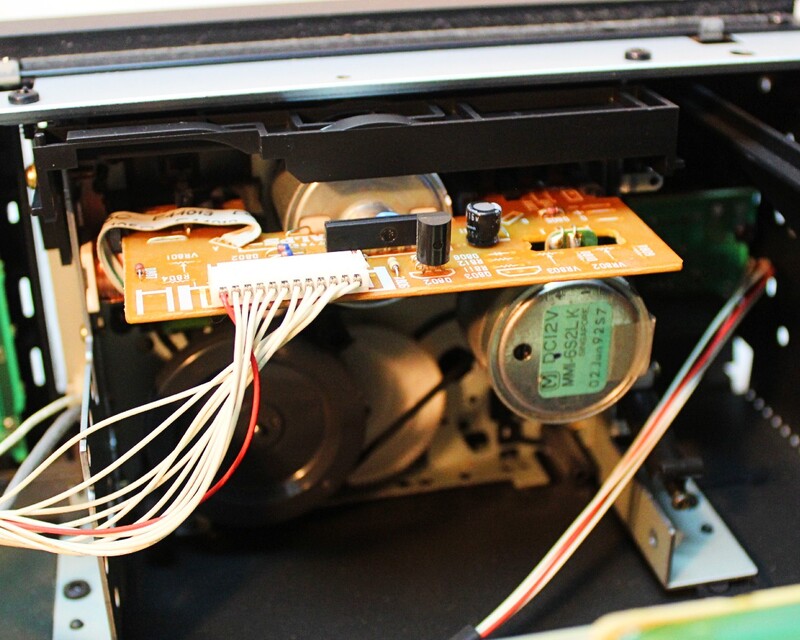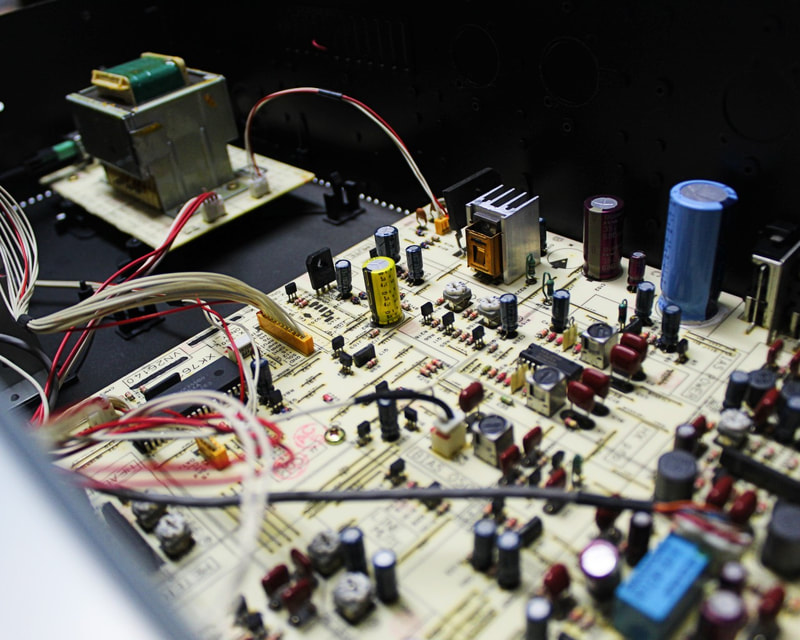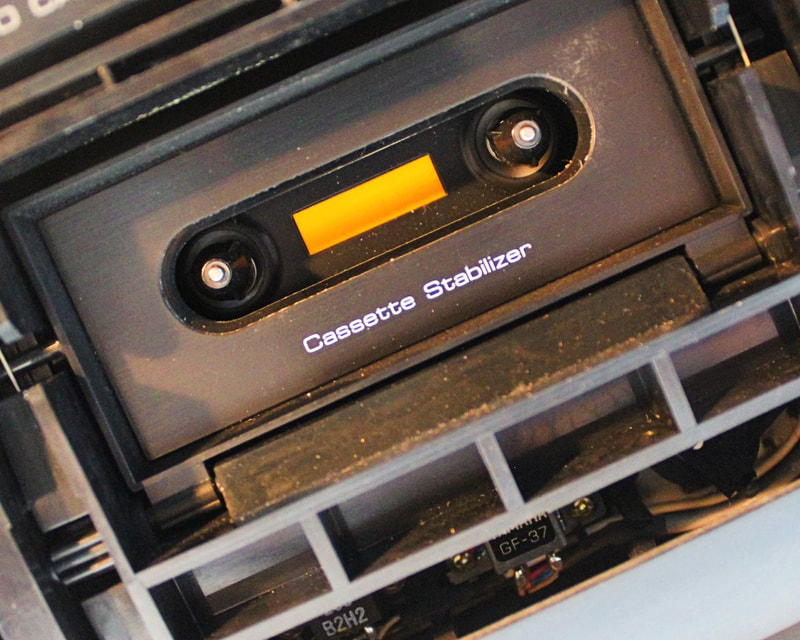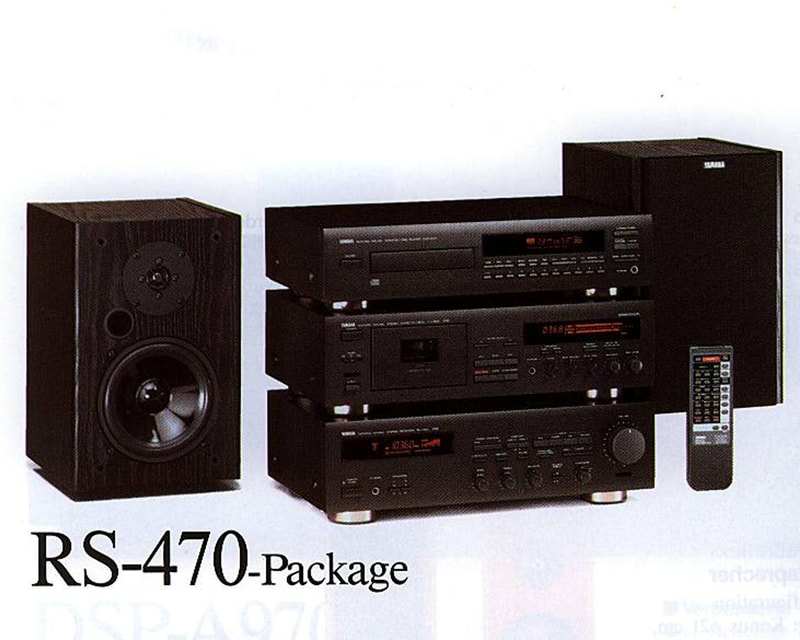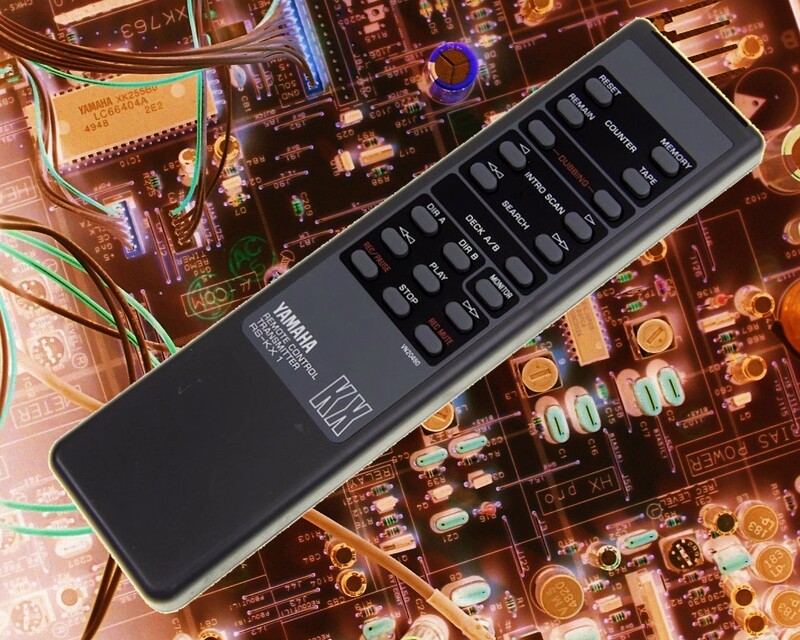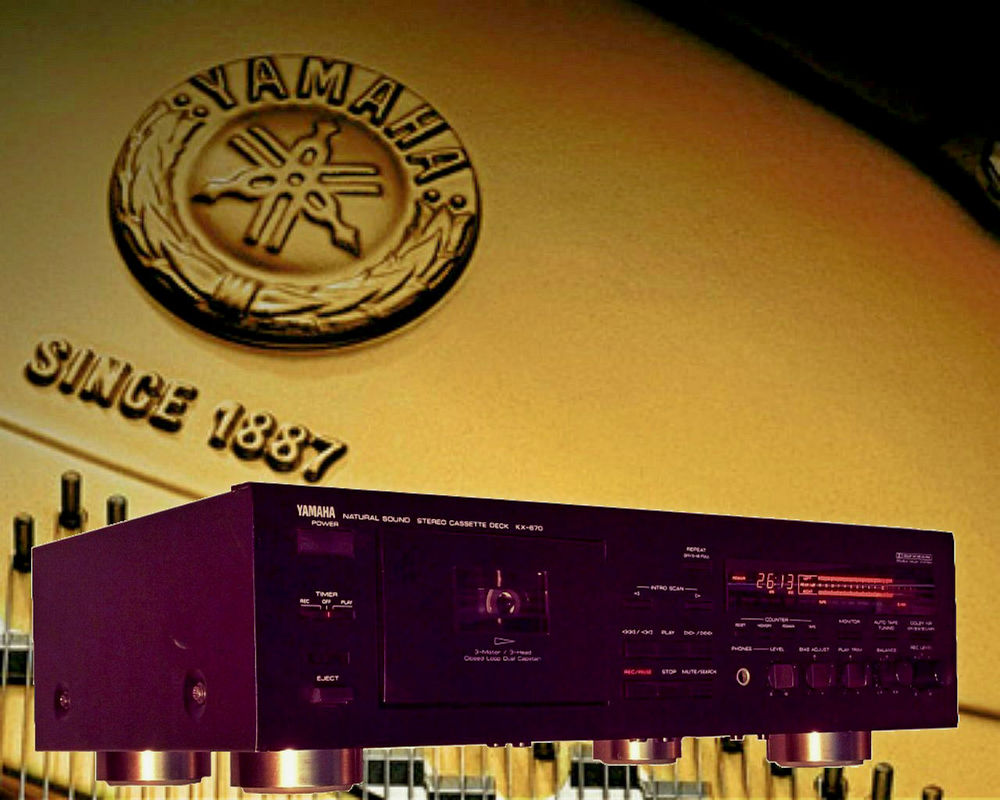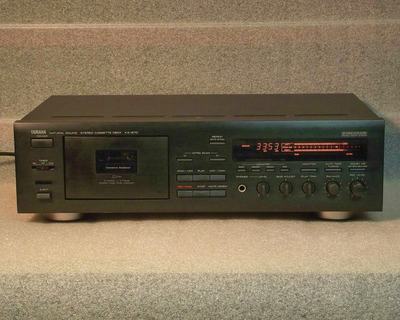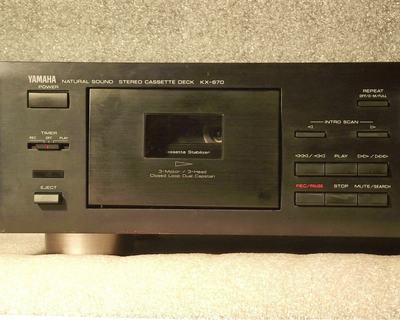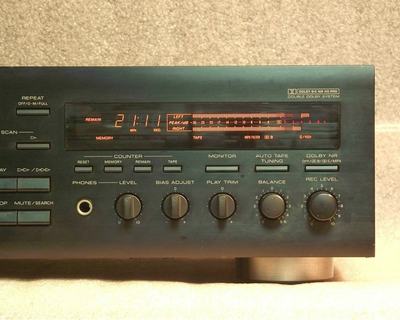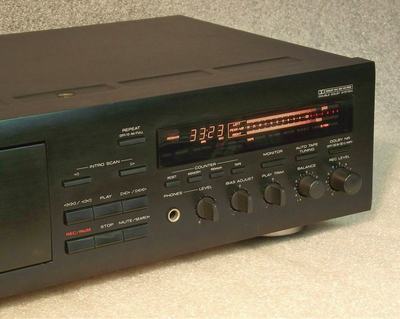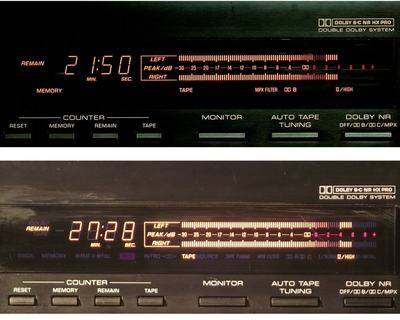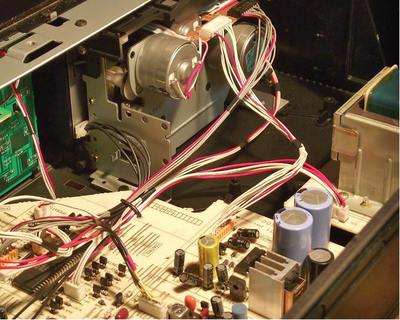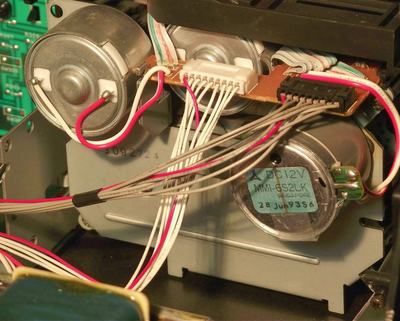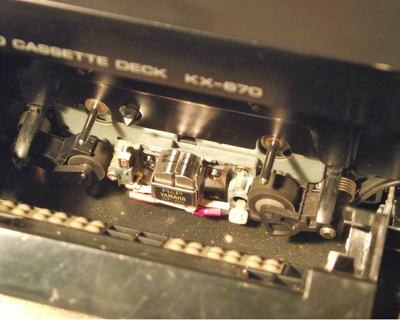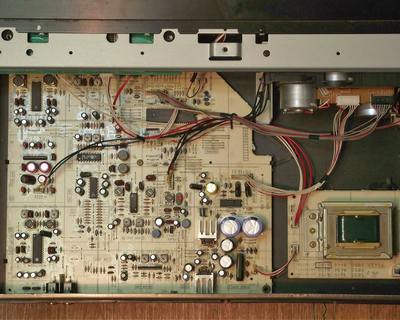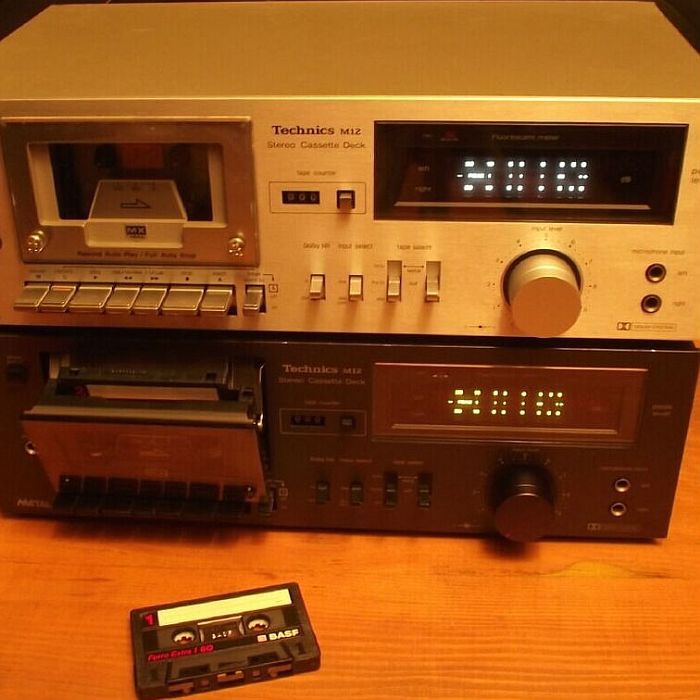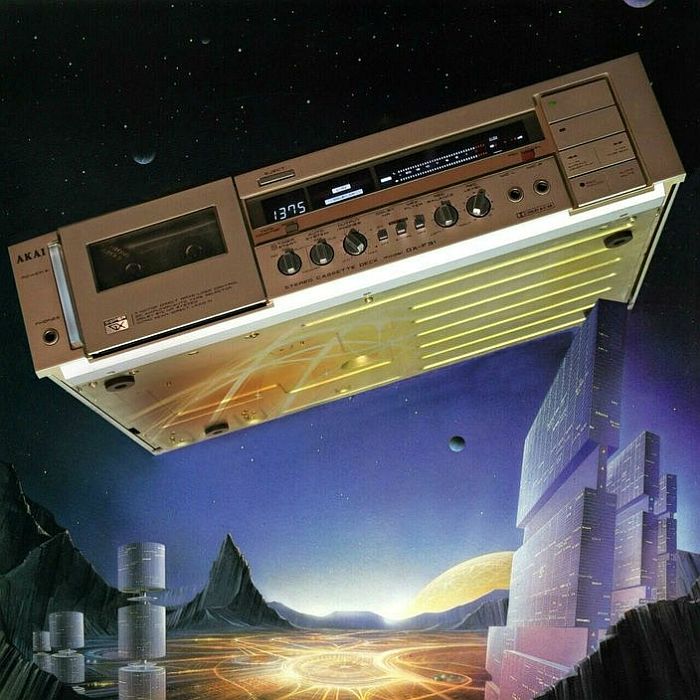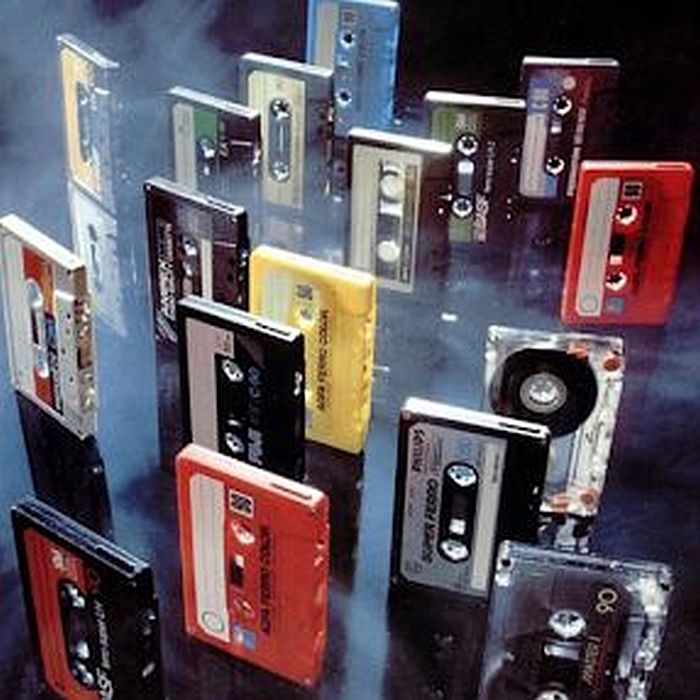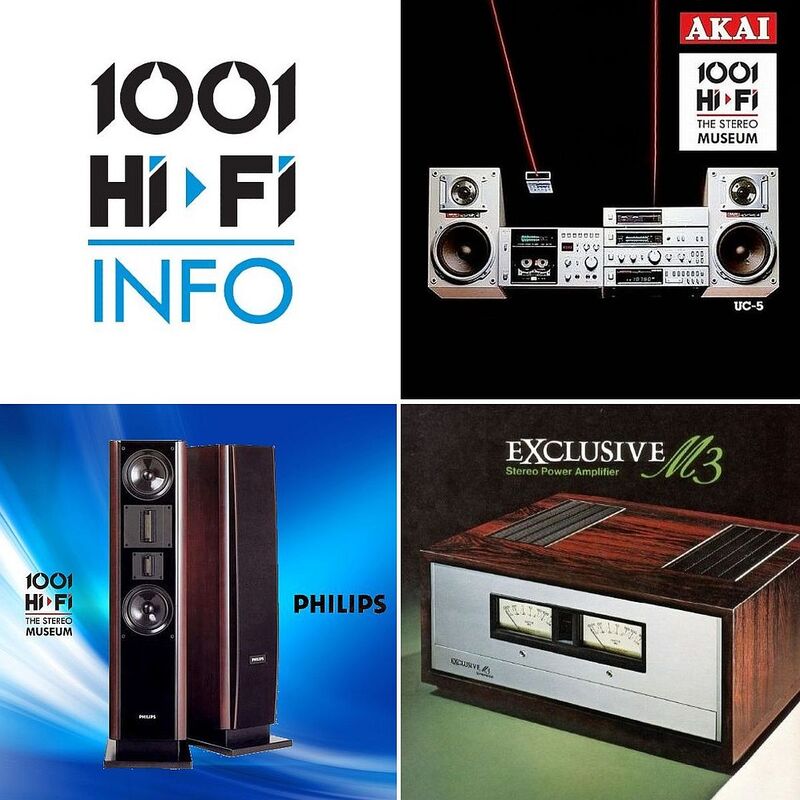CASSETTE DECK 1991 - 2000
The 1001 Hi-Fi Collection
Fine Arts by GRUNDIG CF 11 (1996)
Fine Arts by GRUNDIG. A fine cassette deck indeed, with aluminium front panel and a cassette drawer that features a cassette stabilizer-lock mechanism when the tray is closed (the unit only works with the drawer closed). The deck has a real time counter that auto adjusts itself to the length of the tape it is using. (This process takes several seconds). This is an auto-reverse deck with manual recording level settings and various controls situated behind the flip down front panel. For hiss free recording the GRUNDIG CF 11 features DOLBY B-C noise reduction with HX Pro headroom extension. The deck can be remote controlled even with a PHILIPS audio remote control. (In system or individually) Read more about the matching amplifier on this page.
Cover photo art: Fine Arts - Last update March 16th 2017
Cover photo art: Fine Arts - Last update March 16th 2017
harman/kardon TD420 (1996)
The harman/kardon TD420 was introduced in 1996 as a "CD Transcription Quality" cassette deck. According to the manufacturer, the TD420 has been engineered for wide, flat frequency response, low noise, and low distortion, so as to produce high fidelity recordings from compact discs and other high-quality sound sources. Another highlight of this product is the pure discrete playback amplifier. Instead of using off-the-shelf integrated circuits, harman/kardon designed and built a playback circuitry using discrete electronic components. The TD420 is using a high grade 2+1 motor mechanism mounted horizontally inside the deck while the classic tape door has been replaced with a drawer type cassette holder. There's a small plastic cover on the top from where you can acces relatively easy the head and pinch roller for cleaning but for this, the deck has to be placed on the top of your Hi-Fi stack. The mechanism is indeed well built with gear drive fast winding mechanism, built for longevity. After the drawer closes a cassette stabilizer will hold the cassette in place and absorb vibration.
The deck is equipped with Dolby B and C noise reduction and HX-Pro headroom extension circuit and manual bias control. A large 12 segment peak indicating wide range meter (-35 to +8 dB) is located on the fluorescent display that will also show various functions and incorporates a digital counter. The digital Realtime counter also works for fast forward and rewind but unfortunately it will reset to zero if you open the cassette drawer. Overall, this deck has a solid build quality with aluminium front panel and a proper thickness steel cover but plastic knobs. With partnering components such as CD player, tuner and amplifier you can build an extremely pleasing looking Hi-Fi system. This series from harman/kardon was built in Korea and the weak point of the unit (as with other Korean components from our collection) are the pushbuttons. These microswitches fail to work or create chaos in the logic control but are an easy fix using contact spray or in more severe cases the microswitches can be replaced with new ones. The overall positive experience with this deck is supported by a frequency response of (-20 dB) 20 Hz to 20 kHz +/-3 dB (Metal tape) while the only negative point being the placement of the open/close button (bottom right, far away from the drawer)
Cover Photo Art: Hidden Sounds - Published March 15th 2019
The deck is equipped with Dolby B and C noise reduction and HX-Pro headroom extension circuit and manual bias control. A large 12 segment peak indicating wide range meter (-35 to +8 dB) is located on the fluorescent display that will also show various functions and incorporates a digital counter. The digital Realtime counter also works for fast forward and rewind but unfortunately it will reset to zero if you open the cassette drawer. Overall, this deck has a solid build quality with aluminium front panel and a proper thickness steel cover but plastic knobs. With partnering components such as CD player, tuner and amplifier you can build an extremely pleasing looking Hi-Fi system. This series from harman/kardon was built in Korea and the weak point of the unit (as with other Korean components from our collection) are the pushbuttons. These microswitches fail to work or create chaos in the logic control but are an easy fix using contact spray or in more severe cases the microswitches can be replaced with new ones. The overall positive experience with this deck is supported by a frequency response of (-20 dB) 20 Hz to 20 kHz +/-3 dB (Metal tape) while the only negative point being the placement of the open/close button (bottom right, far away from the drawer)
Cover Photo Art: Hidden Sounds - Published March 15th 2019
JVC TD-X372(BK) (1994)
The JVC TD-X372(BK) was introduced with the 1994 line-up of stereo cassette deck recorders. This was the entry level model, however is much better built and specified as previous entry level models. It uses a 3-motor full logic-controlled mechanism with Pulse Servo Direct Drive capstan motor, 1 DC motor for gear driven reel drive and 1 DC motor for the "Silent Mechanism". For top results there are two ways of making recordings with this cassette deck:
The first one is the usual one where the user manually adjusts the recording level, balance and bias while following the correct level on the 2-color fluorescent peak level indicator. Tape types are automatically selected and a small dot will indicate the maximum recommended level, while the tape counter can be switched into a digital peak level indicator (a helpful feature to easily follow peak recording values). The fluorescent level indicator has markings for 0 dB (IEC standard level 250 nWb/m), 0 VU (EIAJ standard level 160 nWb/m) and Dolby NR standard level while the manual recording level control (input level) has a very nice 1dB step scale printed for reference. Recordings can be made using Dolby B or C noise reduction circuit or without the use of it.
The second way to create recordings is an automated procedure when the cassette deck is used with a JVC CD player equipped with Compu Link (it requires a cable to be connected between the deck and CD player) and DDRP function. When the DDRP (Dynamics Detection Recording Processor) button of a suitable JVC CD player is pressed, the recording level is first adjusted automatically, then recording starts. In this case the adjustment of the input level control is not required. The JVC TD-X372 has no track (music) search system which is actually a good ideea since the weak point of the deck (in terms of longevity and not sound quality) is the METAPERM recording/playback head. The front panel is made of plastic with simulated brushed aluminum effect but this weak point is compensated by the long-term maintenance free Direct Drive capstan motor and gear driven reel drive. Frequency response is (-20 dB recording) 20 - 18.000 Hz for Type IV Metal tape and 20 - 17,000 Hz for Type II and Type I tape. Wow and flutter is 0.045% (WRMS) and signal to noise ratio is 58 db (Dolby Off). One final note: the tape counter functions as a linear tape counter. The running time is displayed in minutes and seconds while it's accuracy will vary depending on the length of the tape and the hub diameter.
Cover Photo Art: Direct Drive Control - Published January 15th 2018
The first one is the usual one where the user manually adjusts the recording level, balance and bias while following the correct level on the 2-color fluorescent peak level indicator. Tape types are automatically selected and a small dot will indicate the maximum recommended level, while the tape counter can be switched into a digital peak level indicator (a helpful feature to easily follow peak recording values). The fluorescent level indicator has markings for 0 dB (IEC standard level 250 nWb/m), 0 VU (EIAJ standard level 160 nWb/m) and Dolby NR standard level while the manual recording level control (input level) has a very nice 1dB step scale printed for reference. Recordings can be made using Dolby B or C noise reduction circuit or without the use of it.
The second way to create recordings is an automated procedure when the cassette deck is used with a JVC CD player equipped with Compu Link (it requires a cable to be connected between the deck and CD player) and DDRP function. When the DDRP (Dynamics Detection Recording Processor) button of a suitable JVC CD player is pressed, the recording level is first adjusted automatically, then recording starts. In this case the adjustment of the input level control is not required. The JVC TD-X372 has no track (music) search system which is actually a good ideea since the weak point of the deck (in terms of longevity and not sound quality) is the METAPERM recording/playback head. The front panel is made of plastic with simulated brushed aluminum effect but this weak point is compensated by the long-term maintenance free Direct Drive capstan motor and gear driven reel drive. Frequency response is (-20 dB recording) 20 - 18.000 Hz for Type IV Metal tape and 20 - 17,000 Hz for Type II and Type I tape. Wow and flutter is 0.045% (WRMS) and signal to noise ratio is 58 db (Dolby Off). One final note: the tape counter functions as a linear tape counter. The running time is displayed in minutes and seconds while it's accuracy will vary depending on the length of the tape and the hub diameter.
Cover Photo Art: Direct Drive Control - Published January 15th 2018
ONKYO TA-2820 (1991)
The ONKYO TA-2820 was the entry level model in the ONKYO lineup from 1991. Just because it was an entry level model it doesn't mean it's a basic model, it has the features and specifications equivalent of a better model from other manufacturers lineup. The deck is built around a solid 2 motor microprocessor-controlled tape transport mechanism with a specified 20-19000 Hz frequency response using Metal tapes. Other features include Dolby B/C noise reduction with HX-Pro headroom extension, manual ACCUBIAS for optimal performance regardless of the cassette you use and remote-control capability when used with a remote controlled ONKYO amplifier or receiver. Tape types are automatically selected while tape operation is displayed on a nice and large fluorescent multifunction display. This model was available with black or silver front panel. In the pictures you can see two black panel models from our collection. Front panel is aluminium but the knobs are plastic and we had to manufacture two plastic replacement knobs for one of the units (the smooth surface bias and balance knobs) Both units perform very well and we are extremely pleased with the results.
Cover photo art: Tape kaleidoscope - Published January 15th 2017
Cover photo art: Tape kaleidoscope - Published January 15th 2017
PIONEER CT-339 (1991)
The CT-339 was introduced by Pioneer in 1991 and it was available for a very short period of time. This is a 2-head model based on a 2-motor ALPS mechanism. The deck is equipped with all the extra functions that will guarantee optimal recording results with any type of tape. Activating the AUTO BLE function before starting a new recording means the deck will record a series of test tones and automatically adjust BIAS, Level and EQ for optimal results with any tape formulation used. The CT-339 is equipped with Dolby B and C noise reduction circuits and it also features HX Pro circuit that will guarantee non-compromised high frequency performance. The counter has two mode, linear counter and time counter while track search can be performed up to +/-15 tracks. Remote control is possible via a cable connected to a remote equipped amplifier while the CD-Deck synchro function makes-it easier to start a recording session from a CD. While the front panel is made of plastic this Made in Japan still feels solidly built and performs with great confidence.
Cover Photo Art: ...the cool logo - Published June 15th 2024
Cover Photo Art: ...the cool logo - Published June 15th 2024
PIONEER CT-S250 (1996)
The PIONEER CT-S250 is a basic, entry level cassette deck introduced in 1996. It features a one DC servo motor mechanism with centre mount design in an anti-resonance and anti-vibration design featuring honeycomb chassis and large insulators. All these design features look fabulous in a brochure but in reality, the deck is just a simple (plastic) machine. Don't get me wrong as its performance is relatively good and the FLEX (Frequency Level Expander) circuit actually works and can add some sparkle to old tapes. Basically, the power spectrum of music shows distribution of energy over the audible range, frequency by frequency. With high-quality recorded music, the power decreases at a certain rate in proportion with frequency ('1/f' curve). This indicates that there are rich high-frequency contents. Poorly recorded materials, however, exhibit a more precipitous power spectrum-and so do worn tapes. The FLEX technology remedies the problem by analyzing the spectrum of music in play and adjusting it to fit the typical "1/f" curve. You get rich, balanced and natural sound from every recorded tape. The fluorescent peak-hold level indicators have Wide and Expanded mode but unfortunately there is only one knob for record level setting without balance control. The counter is a large easy to read 4-digit electronic tape/elapsed-time counter and the whole display can be switched off. It seems that the American market models had orange display while in other regions it was sold with white (blueish) display. The record/playback head is "Hard Permalloy", Wow and Flutter is 0.07% (WRMS) with a Frequency Response (at -20 dB recording level) of 25 to 18,000 Hz (+/-6 dB Metal tape). On the positive side it has to be mentioned that the deck still uses the old "original" and best PIONEER logo. And one more thing, check the close-up photo of the small, secret, azimuth screw acces hole cover.
Cover Photo Art: The Re:F.L.E.X. - Published August 15th 2020
Cover Photo Art: The Re:F.L.E.X. - Published August 15th 2020
SONY TC-K411 (1993)
The TC-K411 was the smallest 3-Head model in the SONY cassette deck range from 1993. It features a 2-motor belt drive mechanism (TCM-190VB11) with a 3-head (SD) system configuration for best recordings. For best recording results with any tape, the TC-K411 is also equipped with calibration test tones. There are manual calibration knobs for bias and record level that can be perfectly balanced with the help of the VU meter that will turn into calibration mode during these test recordings. For better high frequency response, the TC-K411 also features Dolby HX-Pro circuit and Dolby B and C noise reduction circuits. All controls are well laid out and the deck features a nice and informative display with a real time counter. Even though the deck features all the necessary features for good recordings it still feels cheaply built. Overall, the results are OK (after a belt and pinch roller replacement and general maintenance) but still not up there with favorite models from our collection. Specifications: Wow and flutter: 0.07% WRMS / 0.18% DIN | Frequency response: 30-17,000/18,000/19,000 Hz (normal/chrome/metal) | Dimensions: 430x123x310 mm | Weight: 4kg. Original sale price: 449 DM in Germany.
Cover Photo Art: To The Power of 3 - Published: October 15th 2021.
Cover Photo Art: To The Power of 3 - Published: October 15th 2021.
SONY WM-FX221 (1995)
The SONY WM-FX221 was introduced in 1995 and was the smallest member of the radio-cassette WALKMAN line-up. Other models of the series were the SONY WM-FX421/FX423/FX425. The unit can be operated either with two AA batteries or with an external power source through the DC IN 3 V jack located on the right side of the unit. It allows playback of Normal/CrO2/Metal tapes with or without Dolby B noise reduction. Alternatively, you can listen to FM or AM radio broadcasts using the built in radio receiver. No external antenna is required for radio reception as the headphone cable doubles as antenna for radio signal. The unit has also a built-in clock and with the supplied belt clip, you can wear your WALKMAN on a belt for convenient use.
Published September 15th 2016
Published September 15th 2016
UHER UCT-252CR (1992)
The UCT-252CR cassette deck was introduced in 1992 as part of the so-called Classic series by Uher. By this time Uher, once famous for their portable tape recorders, was nothing but a brand name owned by Harman International, as a consequence this deck was Made in Korea. Technically it features a one motor mechanism in a two head configuration recorder. While a mechanism like this is less sophisticated than a "classic 2-motor configuration" it performs actually well and it's reliable. The deck features both Dolby B and C noise reduction circuits (a Sony CX20187 IC) together with HX Pro headroom extension and manual Bias. There are however some aspects that should have been done better. The tape selector for example is automatic but there is no visual confirmation on what tape has been selected. In time these leaf switches become oxidized and the wrong tape type will be selected, without a visual confirmation you won't notice this misbehavior. Cleaning heads and tape path is also difficult because the door panel is not removable. As a comfort feature the Uher UCT-252CR has system remote capability. With a amplifier from this UHER range, like the UA-220R, the cassette deck can be remote controlled with the amplifiers hand-held unit after the deck is connected to the amplifier via a remote cable. Technical data: Wow and Flutter: 0.1% DIN | Frequency response 25Hz-17/17/18kHz (normal/chrome/metal) | Dimensions: 435*120*258 mm | Weight: 3.6 kg
Cover Photo Art: Shadows of a Past - Published: April 15th 2021
Cover Photo Art: Shadows of a Past - Published: April 15th 2021
YAMAHA KX-360 (1992)
Very nice 2-head cassette deck recorder from Yamaha. It features everything you would want from a 2-head deck, and even more. The KX-360 from 1992 features a two-motor logic-controlled tape transport (very easy belt change) mechanism fitted with a Yamaha GF-37 Hard permalloy recording/playback head and a cassette compartiment door fitted with Cassette Stabilizer. For best recording the deck features manual Bias adjustment, Dolby HX-Pro Dynamic Headroom Extension circuit, Dolby B and C noise reduction and a very nice and easy to read (16 segment) peak level meter with manual recording level adjustment. A series of comfort functions can also be found on the KX-360 such as: timer rec/play, digital counter, memory stop, memory repeat, music search and both way introscan. One feature in particular is highly regarded by tape enthusiasts and that's the Play Trim adjustment. With the help of this front panel adjustment, you can easily bring new life to old and dull sounding tapes or you can attenuate the effect of bright sounding tapes. Another great feature is the front panel headphone socket with volume control. The KX-360 can be remote controlled with a dedicated RS-KX1 infrared remote control (sold separately) or with a Yamaha system remote control. In both situations the remote will transmit the signal directly to the infrared receiver of the cassette deck (no system remote cable is necessary). The most common version of this deck is black, but it was also available in Yamahas "Titanium" finish. Technical data: Wow&Flutter 0.05% WRMS | Frequency response 20-20.000 Hz Metal tape | Size 435x131x283 mm | Weight 4.8kg.
Cover Photo Art: Amber Vision - Published January 15th 2023
Cover Photo Art: Amber Vision - Published January 15th 2023
YAMAHA KX-670 (1993)
The Last of the Mohicans. In 1993 cassette deck as a recording medium was in sharp decline. In its last effort YAMAHA launched their last top of the line model. (OK, there was one more in 1996, the KX-690 but that was more a cosmetic change and added Dolby S noise reduction) It was built as an ultimate deck with all the features you could imagine for a serious cassette recorder. The heart of the deck is a 3 motor Dual Capstan drive mechanism with YAMAHA GF-50 permalloy heads in a 3 head configuration. For an improved playback experience the YAMAHA KX-670 includes special features such as two speed fast winding, cassette stabilizer, linear (remain) time counter based on preselected cassette length, track search, various memory stop/repeat functions and most importantly a play trim control. With the help of Play Trim control adjustment, you can boost high frequencies if they are absent or you can attenuate high frequencies when distortion is noticeable. This is an extremely helpful feature for playback of cassettes recorded with other recorders that used Dolby noise reduction. The 3 head configuration allows you to monitor the recorded material in real time. For best recording results the YAMAHA KX-670 has a built-in Auto Tape Selector which automatically adjusts the recording characteristic according to tape formulation and a Dolby HX Pro Dynamic Bias Servo System which automatically controls the effective bias during recording. To further improve recording characteristics with any tape you use this deck has a Auto Tape Tuning function that makes critical adjustment of the deck's recording bias and sensitivity.
With the Auto Tape Tuning function, the recording characteristics (recording bias and sensitivity) are automatically adjusted in three frequency ranges (100 Hz, 3 kHz and 10 kHz) while repeating recording and playback operations several times in about 8 seconds, to accurately match the characteristics of the loaded tape. If further adjustment is needed there is a manual Bias Adjust as well. The deck was available in black or Titanium finish while the YAMAHA RS-KX1 remote control transmitter was available as an optional accessory. I don't have the optional remote control but the deck works well with a compatible YAMAHA remote control that I have for an amplifier. Specifications are very good with a frequency response of 20 - 21,000 Hz +/-3 dB (-20 dB) Metal tape / wow and flutter less than 0.04% / signal-to-noise 60/76 dB (Dolby off / C on). Overall results for this deck are very good, this is a recommended cassette deck for serious recording enthusiasts.
Cover photo art: The Last of the Mohicans - Published December 15th 2017.
Cover photo art: The Last of the Mohicans - Published December 15th 2017.

